4 Days in Paris: A Perfect Itinerary (for First Timers)
Paris is a magical city, and we can’t get enough of evening walks along the Seine, leisurely lounging next to a fountain in the sun, and devouring as many (gluten free) pastries and glasses of French wine as we can.
However, it’s also worth remembering that Paris is a BIG city – something we’ll reiterate multiple times throughout the guide below – not some fairytale small town.
Mismatched expectations – the contrast between the idea that Paris is some romantic riverfront village and the reality that it’s a massive city – is what we think is at the core of the “Parisians are cold and rude” sentiment that you’ve almost certainly heard from someone in your life (usually someone that hasn’t been to Paris in a while).
In our experience, which is based on three trips (spanning just under a month) in the past three years – with the most recent trip coming last winter – that stereotype is simply not true anymore.
Are Parisians particular about greeting with “bonjour” before getting down to business (e.g. ordering coffee)? Yep.
And as long as you know those nuances going in, you’re going to have a great time (which is exactly what this guide is for!).
We absolutely love Paris, and we’re pretty sure you will too (especially if you’re armed with this guide).
We have put all of our tips, tricks, and discoveries into this guide to help you plan an amazing trip, especially if it’s your first time.
In this guide to planning your trip to Paris, you’ll find a detailed 4 day Paris itinerary, complete with things to do, see, eat, and drink, along with the important details you need to know like how to see the Eiffel Tower and the best way to tackle the beast that is the Louvre.
You’ll also find logistics – like how to get around and some useful tips and tricks for visiting Paris – that are important for planning your trip.
We hope you enjoy this guide, that you find it helpful for planning your trip, and we help you discover something new and exciting, whether it’s your first time, or tenth.
Sound good to you? Let’s get into it.
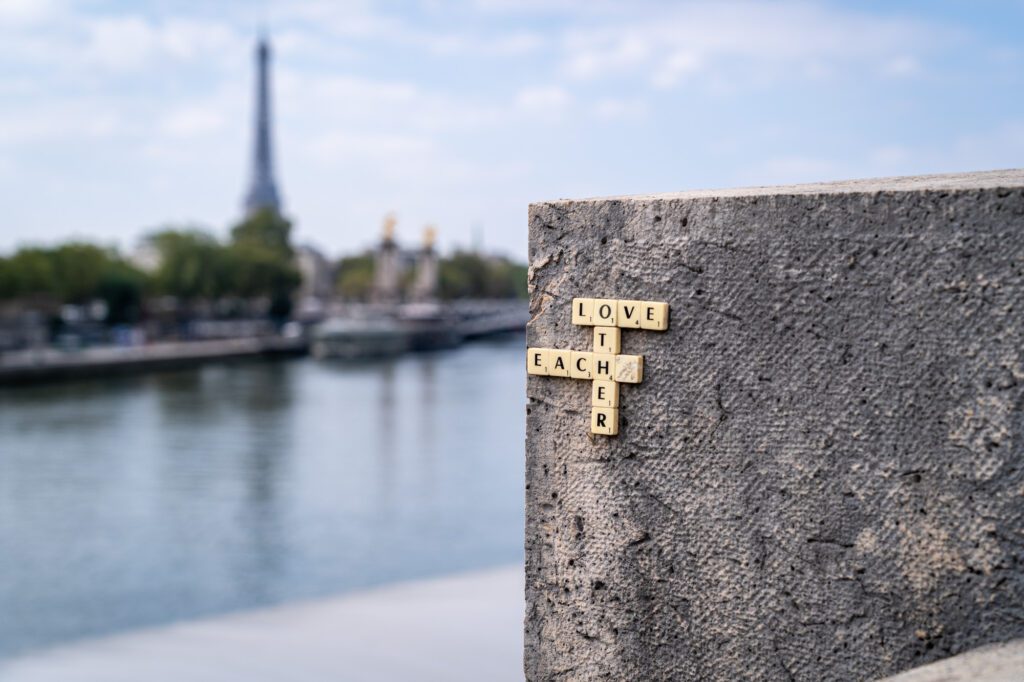
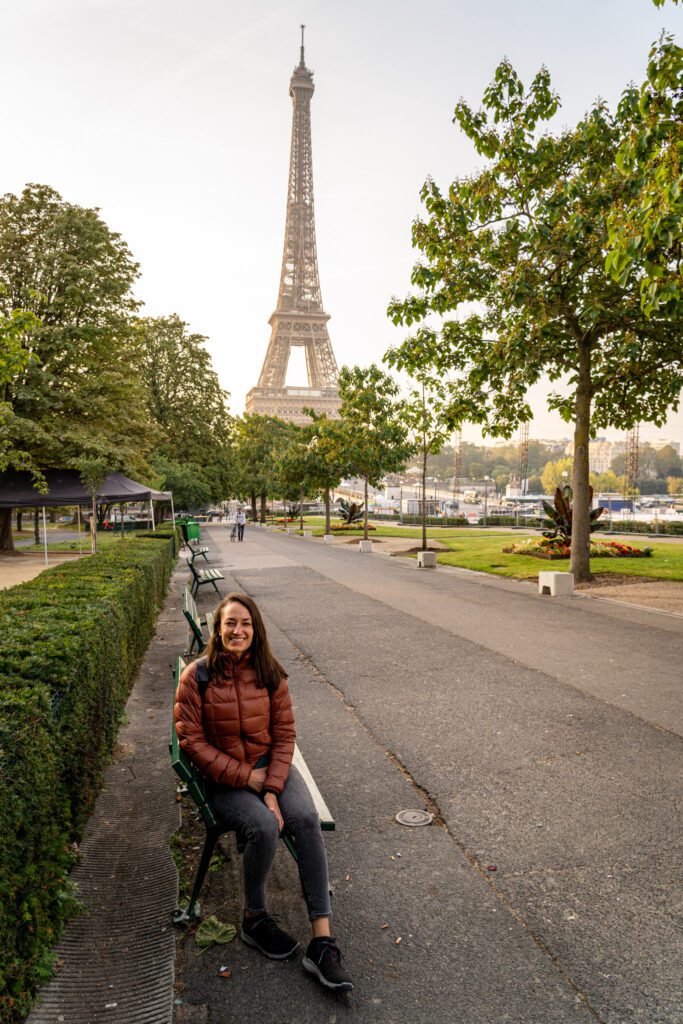

Disclaimer: Some of the links in this post, like hotel links, are affiliate links, meaning at no additional cost to you, we make a little bit of money if you click through and book. That being said, we would never recommend something to you that we don’t stand behind 100%.
How Many Days Do You Need in Paris?
The biggest realization from my recent trip is that Paris is somehow simultaneously massive and compact.
Let me explain.
If you look at it on a map, the area that you’re going to be spending your time in as a visitor is relatively small when you think about it as a piece of the broader city (it’s basically just the part of the city that’s along the river, with a few deviations to places like Montmartre).
However, Paris is a BIG city, and even that little chunk of the city is pretty big – it takes an hour and a half to walk from the Arc de Triomphe to Place de la Bastille (which is roughly the furthest west/east you’re going to go).
And that doesn’t take into account the fact that the city is PACKED with things to do, see, eat, and drink.
The point is, we think that four days is the absolute minimum you should spend in Paris.
Anything less will have you jetting around from sight to sight with no time to relax and experience what truly makes Paris special.
A long, wine-filled lunch. The cobblestone streets in Montmartre. Wandering Le Marais. Relaxing on the banks of the Seine or under the Eiffel Tower.
With four days, you’ll comfortably be able to fit in the two big museums (the Louvre and Musée d’Orsay), the Eiffel Tower and Arc de Triomphe, and a day trip to Versailles.
This itinerary is meant to help you see the best of the city without needing a vacation from your vacation.
If you have more time, we have recommendations below in the “more time” section on how to spend it.
However, you could also just pick a neighborhood and spend a day wandering from shop to shop, coffee to coffee, wine bar to wine bar. That sounds like a perfect day in Paris to us.
Where to Stay in Paris
The first thing you need to know here is that there are a nearly unlimited number of places you could stay in Paris.
Paris is divided into neighborhoods called arrondissements – each has its own history and personality.
If you look at the city map, imagine a snail’s shell coming out from the very center and circling clockwise and you’ll get the logic behind the numbers.
We have an entire guide dedicated to choosing a place to stay in Paris, which you should read for far more detail than we have in this summary.
Here’s a quick summary of that guide if you’re short on time (though we’d recommend reading the section of the place you end up staying for tips and places to add to your list!).
If it’s your first time in Paris, our recommendation is that you stay in Le Marais, the heart of medieval Paris. This is Paris at its best, we think, and it’s about as central as it gets.
You have excellent walkability to basically every main site in Paris, the best transit connections in the city (including to the airport), and many of Paris’ best places to eat, drink, and shop right outside your front door. Plus, a bunch of hotels (though, as you might imagine, it’s not cheap!).
In Le Marais, stay at the (relatively) affordable Hôtel National Des Arts et Métiers, or Hôtel Jules & Jim if you’re looking for one of the best hotels in Paris.
If you’re looking for a cool neighborhood with lots of food and drinks, stay in the 2nd Arrondissement, a new personal favorite after one of our recent trips.
If we were moving to Paris, we’d move to Sentier, a slice of the 2nd near all of our favorites in the neighborhood. The 2nd is adjacent to Le Marais, and offers many of the same benefits with a slightly lower price tag (generally speaking).
Stay at Le 123 Sébastopol, which might just be the best value in the entire city of Paris, or at CitizenM Opéra (CitizenM is one of our favorite hotel chains in the world, and we’ve stayed at multiple locations across multiple countries – highly recommend!).
If you’re on a budget and looking for a blend of affordability and convenience, stay in the 9th Arrondissement, which is central and affordable with great nightlife.
For what it’s worth, we stayed in the 9th on two recent trips (first at the super affordable Hotel Joyce, then at the excellent Maison Mère), and it was a great home base for exploring the city.
Plus, a bunch of our favorite wine bars / coffee shops / restaurants in Paris turned out to be in the 9th (or on the border), which is another major pro for staying here.
If you’re looking for a romantic getaway, you should absolutely stay in Montmartre (the 18th Arr.), where you’ll find cobblestone streets and a former village – home to many of the most famous artists in history like Van Gogh, Renoir, and Picasso – on a hill above Paris that has since been swallowed up by the ever-expanding city.
It has all the charm of a medieval village straight out of a fairy tale, but the location up on the hill is a little further out than some people might prefer (especially if it’s a shorter trip).
I splurged at Terrass on my latest trip in one of their Eiffel Tower view rooms, and it was MAGICAL (but not cheap).
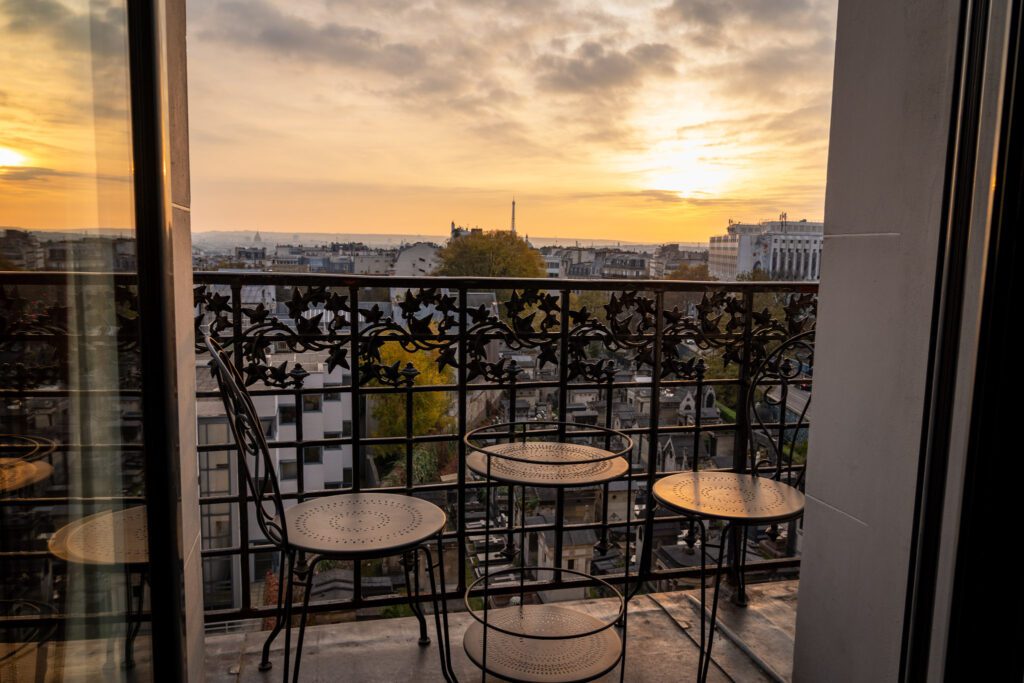
For a more budget-friendly option, look at Hôtel Monsieur Aristide or Hôtel des Arts Montmartre.
Read More: Where to Stay in Paris (Complete Guide for First Timers)
4 Days in Paris: A Perfect Itinerary for First Timers
And now, let’s get into the meat of this itinerary.
We have a secret for you. And it’s a lesson that it took us years of traveling to finally learn on our three month European extravaganza a few years ago.
Travel is better – and by better, we mean more rewarding, interesting, and fun – when you try your best to connect with locals to see the place through their eyes.
I (Matt here!) took that to heart on my last visit to Paris in an effort to better understand what makes the city special, and came away with a much richer understanding of Paris’ unique culture and point of view on life.
Particularly on that latest trip, I did a bunch of different tours and experiences (I’ve included the ones that I thought were particularly special in the guide below) that opened my eyes to a new side of the city, culture, and people.
Our biggest tip for Paris (or any city, really) is to prioritize tours that connect you with locals and allow you to get a unique perspective on the city (which is what you’re going to see in this itinerary).
In terms of structure, we always do our best to anchor the days in our itineraries around a main experience, with time on either side for things like coffee, cocktails, and good old fashioned wandering around a neighborhood.
And we never, ever do multiple museums in a single day. Trust us and learn from our mistakes – you WILL be exhausted by the time you get to the second one, and will get a lot less out of it.
With so much to experience in Paris, it’s definitely tempting to try to pack in all the sights, but then you’ll find you don’t have much time to “live like a Parisian”. And that would be a shame.
To make the most out of Paris, plan to do one or two major sights a day, and dedicate the rest to walking around the neighborhoods while leaving yourself energy to go out for a drink and some dancing or live entertainment in the evenings.
What to Book in Advance: In general, to make sure you’re actually able to make it to some of the top sights in Paris, we’d recommend booking 2-3 months in advance for the Louvre, Musée d’Orsay, the Eiffel Tower (if you want to go to the top), and Versailles.
This is particularly important if you’re visiting over the summer, when we’ve seen crazy lines for some of Paris’ top sights, and it’s less important in the off-season (though we’d still book the Louvre in advance).
Here’s an overview of the 4 day itinerary you’ll find below:
- Day 1: The Left Bank, Saint-Germain, and the Eiffel Tower
- Day 2: Gothic Churches, the Louvre, and the Arc de Triomphe
- Day 3: The Coolest Neighborhoods in Paris and a Foodie Experience
- Day 4: A Day Trip to Versailles
Below the detailed itinerary, you’ll find some suggestions on what to do with more or less time on your trip to Paris, including options for compressing this itinerary into one, two, or three days.
A few things to note about the itinerary we’re about to get into.
- We believe pretty strongly that you should skip going to the top of the Eiffel Tower, and have a few different places where you can get a better (we think) view of Paris for far less hassle. Instead, picnic at the base and walk across the river to Trocadero for nice views of the tower.
- We also believe that the Champs-Élysées, while a beautiful wide boulevard that is emblematic of Paris, is just about the least “Parisian” place imaginable. It’s full of multinational chains that you could find in literally any big European city. Don’t spend more than 30 minutes on the Champs-Élysées. The Arc de Triomphe, however, is great!
- Many museums and attractions have a day that they are closed (for example, the Louvre is closed on Tuesdays), so plan accordingly.
- Many museums have a night where they are open late, which allows for locals to enjoy them after work. This is a great time to visit, but it depends on what else you have going on in your itinerary.
Another note here at the top: This itinerary is jam-packed! There’s a ton to do and see (and eat, and drink) in Paris, and fitting it all into four days is impossible.
To that end, we’ve made some hard choices (like the choice not to bother going up the Eiffel Tower) that are based on our own experiences in Paris in an effort to help you maximize your time and enjoyment.
One of those choices is to include Versailles in the itinerary, rather than in the “more time” section. To be honest, we could go either way.
We’d prefer adding Versailles only if you have five days or more, but we think you can fit it into four if you’re willing to skip some other things, like a walking tour about the French revolution or a visit to an additional museum.
Last, but certainly not least, we’re not going to give specific recommendations on places to eat for two reasons.
One, Matt has Celiac Disease and French food is absolutely TERRIBLE if you need to eat gluten free (there’s flour or bread in everything!), so we’re not really the right people to give that advice (except for the best gluten free restaurants in Paris, which we have plenty of opinions about).
Two, it depends so much on your tastes and budget. So we’ll let you figure that out on your own, for the most part.
Day 1: Exploring the Left Bank
On your first full day in Paris, we’d skip the Louvre (save it for a day when you’re less jetlagged) and get oriented to the city by exploring the “Left Bank” of the Seine, which refers to the south side of the river (and is a very common way that you’ll hear people talk about Paris).
A quick side note on the two banks.
The names, which can be confusing if you don’t know this already, are derived from which side of the river they’re on if you’re looking downriver (or, put another way, in the direction that the river flows).
The Seine flows through Paris from east to west, so if you’re looking west down the river, the 5th, 6th, and 7th Arrondissements are on the left side, while the 1st – 4th Arrondissements are on the right side.
Historically speaking, the left bank has been known as the more creative, philosophical side of the river, where artists, writers, and revolutionaries hung out, while the right bank is the more aristocratic side, where the royal palace and the associated court was located.
Today, that stereotype is less true than a couple hundred years ago, and we’d almost say that it’s flipped if you look at the 6th and 7th Arr., where housing is basically occupied by rich foreigners at this point.
Anyway, the first day is focused on the Left Bank, where you’ll work your way from east to west, starting in the Latin Quarter (the 5th Arr.), hitting our favorite museum in Paris, and ending in the 7th Arr. at the foot of the Eiffel Tower.
The Latin Quarter
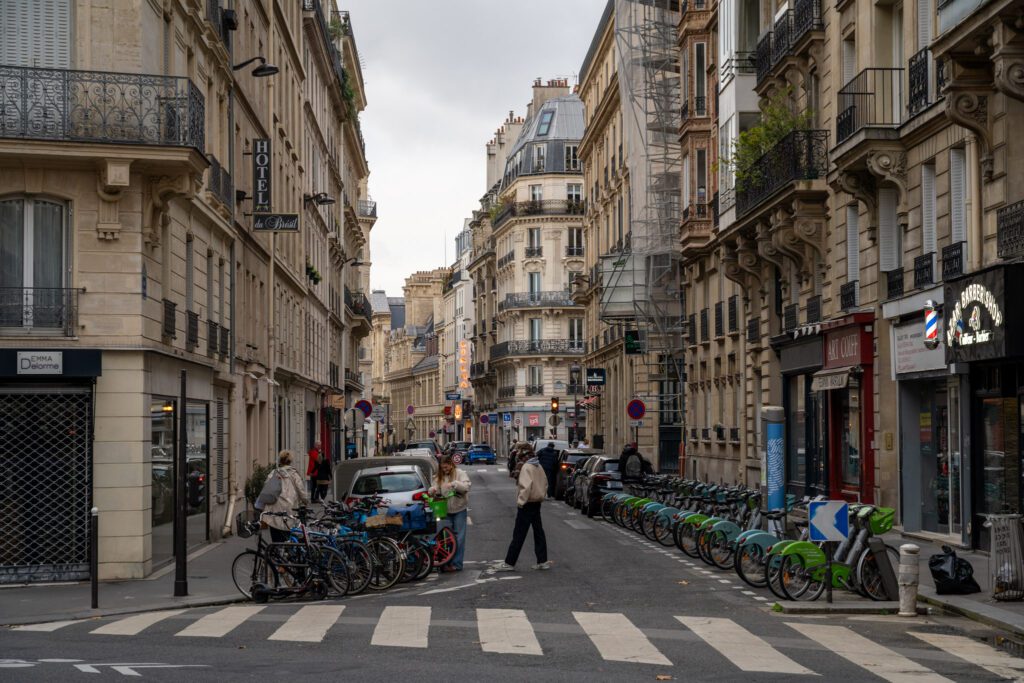
The Latin Quarter is our favorite part of Paris’ Left Bank (at least of the arrondissements along the river).
While the 6th and 7th feel very stuffy and, for lack of a better word, aristocratic, the 5th (which is the Latin Quarter) is a little more lived in.
I stayed here on my latest trip for almost a week, and was surprised at how often I encountered people that actually lived in the neighborhood while I was out and about (which is certainly less true in just about every other arrondissement in the single digits).
Having a neighborhood that is “more local” is a little bit of a stereotype, and I did some thinking while I was wandering around Paris solo about what this really means.
To me, it means that people actually live there and so you have a range of businesses catering to those locals rather than a string of souvenir shops geared towards tourists with the exact same Eiffel Tower snowglobes that they imported from elsewhere.
That means you’re swapping those souvenir shops for a boulangerie, fromagerie, coffee shop, wine bar, bistro, and other places that I – and people like me – would actually want to hang out. Which is great!
The 5th has that in droves, along with two key spots that you definitely shouldn’t miss.
The first, and your first stop on the trip, is the Jardin du Luxembourg, which is our personal favorite of the many green spaces in central Paris (and it was created in the 17th century!).
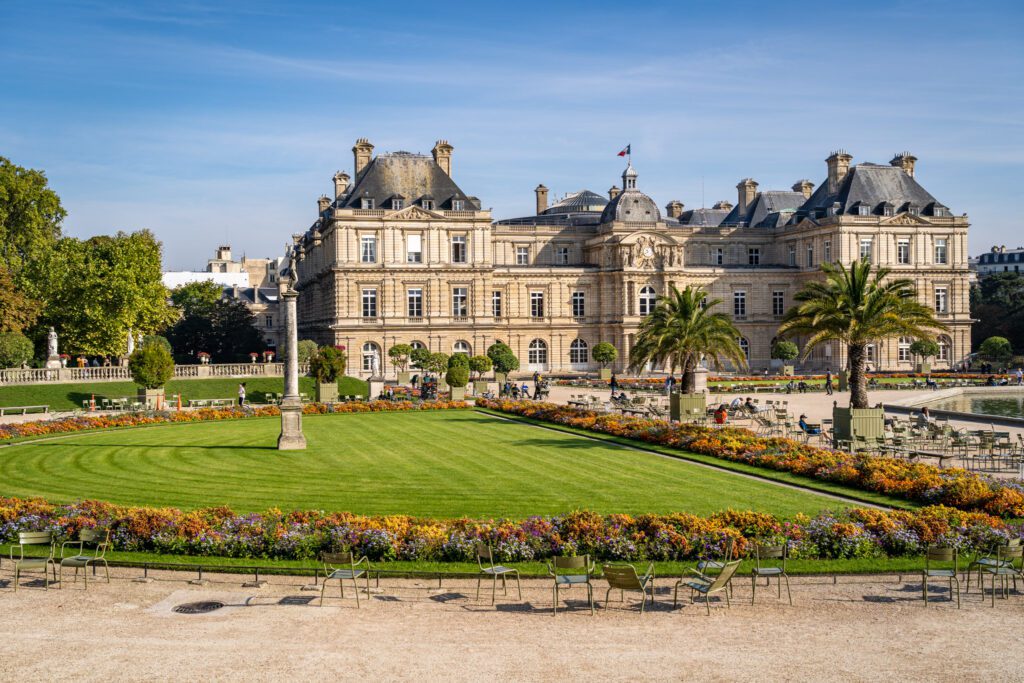
We have been known to stop by a (gluten free) bakery nearby to pick up some pastries and head over to the gardens to bask in the warm sun, surrounded by greenery, fountains, sculptures, and people with a similar idea (including the old men playing Pétanque, which is kind of like bocce ball).
Technically, it’s in the 6th, but as you walk to the eastern side of the park you’ll be in the perfect position to wander up towards your next stop.
That next stop? The Panthéon.
Which, unlike the Panthéon that you’ll find in Rome, is not a pagan or Catholic religious site (it was at one point, but not today!), but is the burial site of “great men,” whatever that means.
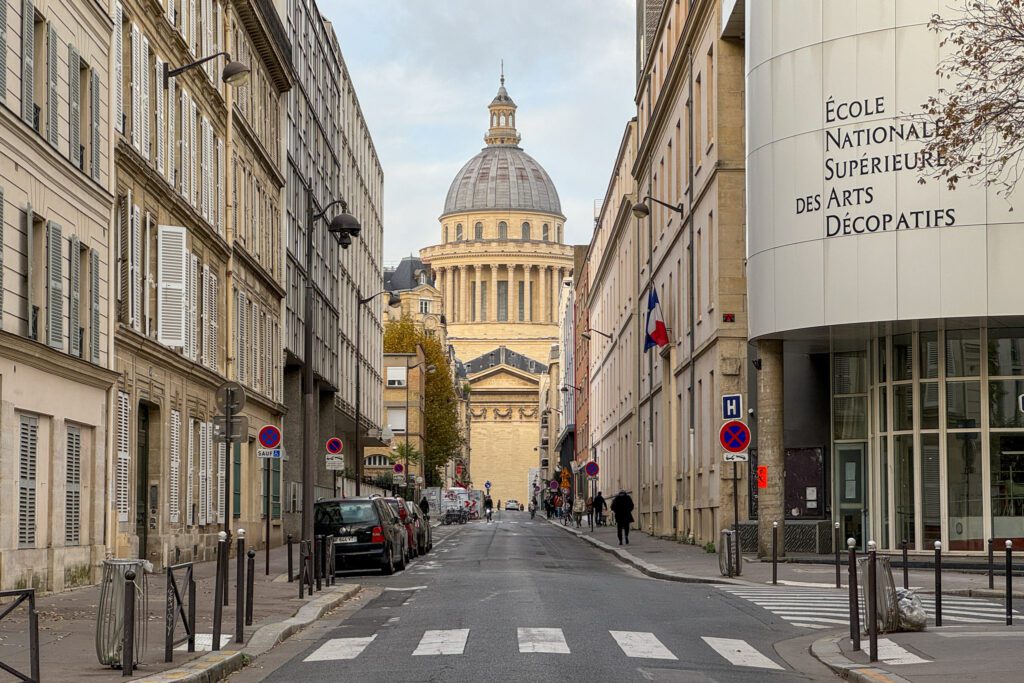
Originally, this was set to be a church, which is fairly obvious from the structure of the building from the outside.
But as it was completed, the French Revolution had descended on Paris. One of the tenets of the French Revolution was breaking away from the Catholic Church as the ultimate power source (e.g. the divine right of kings), and so the church was rebranded into a mausoleum.
Victor Hugo, Jean-Jacques Rousseau, and Voltaire are examples of said “great men™” buried here.
While the interior is cool, the real reason that the Panthéon is on this itinerary – and why it is specifically in the morning – is that the dome offers a great view out over the rest of Paris.
And it’s best in the morning, when the sun is at your back and not directly overhead or behind the Eiffel Tower in the distance.
The Panthéon opens at 10am, so our recommendation is to take a nice morning walk through the gardens (maybe with a pastry and some coffee from a bakery nearby), and then walk up to Panthéon to be there around opening, when the light will be best for photos.
You should know, however, that the dome of the Panthéon closes during the winter (I know because it closed a couple of days before I tried to go in mid-November!).
We probably wouldn’t go inside if this is the case, but it’s up to you and your interests. There will be plenty of other church-like buildings on the rest of this itinerary.
Another note: It’s an extra few Euros to include the dome in your ticket. We’d do it, because the view from the dome is a big part of the reason it’s on this itinerary.
From there, make your way west through Saint-Germain, the 6th Arrondissement, out to the river for your next stop.
A Crash Course in Impressionism at the Musée d’Orsay
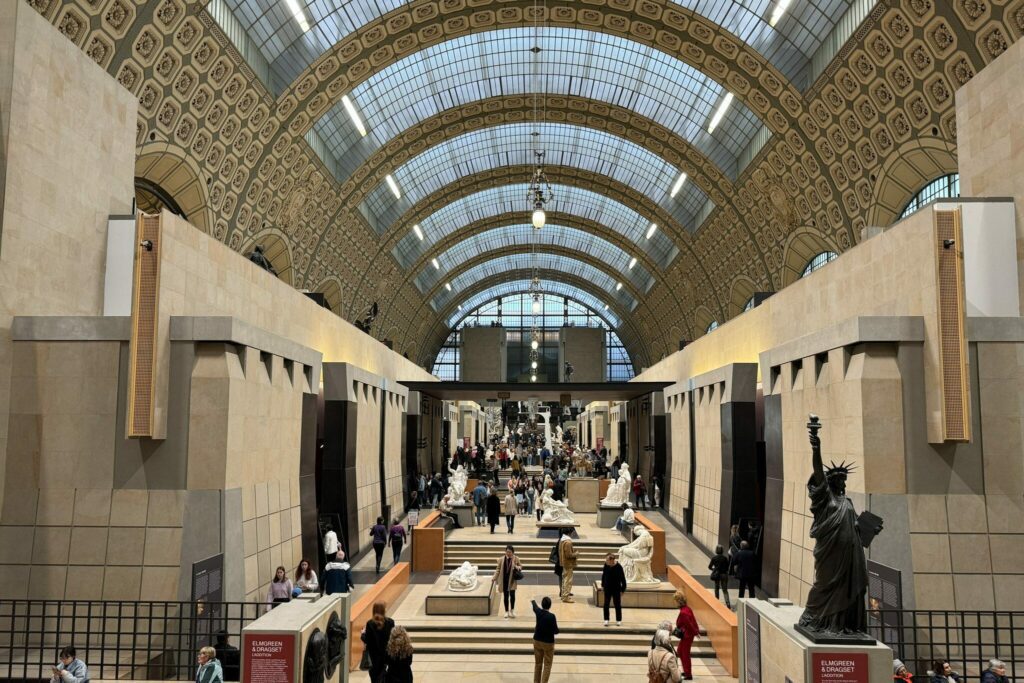
While the Louvre is the most impressive museum in Paris in terms of its size and scope, the award for our favorite museum in the city has to go to the Musée d’Orsay (although the Rodin Museum is a close second!).
Now, we’re definitely not saying that the Louvre isn’t worth seeing (you’ll find it on day two of this itinerary).
But we ARE saying that it’s a somewhat overwhelming and intimidating collection.
And I just really love the impressionists, who were very much the bad boys (and a few ladies, too!) of the art world in their heyday.
Funny enough, the two museums are very much related – the collection that lives at the Musée d’Orsay today was originally housed at the Louvre before it was moved here when the train station was decommissioned (the building used to be a train station before Paris outgrew it).
I’m a sucker for landscapes and bright colors, which puts me right in the bullseye for the target audience of the Impressionists.
I had been to the Musée d’Orsay twice before my most recent trip to Paris, but it had been a decade since my last visit and I felt like it was time to revisit what I remembered as my favorite museum in Paris.
One of the biggest learnings about myself over the past few years of traveling is that I’m really bad at doing art museums by myself. I really need the context and storytelling to capture my interest and help me understand what exactly I’m looking at.
Which is why I decided to do Carine’s tour of the museum, which I had tried to set up on my previous solo trip to Paris, but our availability didn’t overlap.
Carine was GREAT. She studied art history at the École du Louvre, which seems like the perfect person to teach about Impressionism and its rise in France.
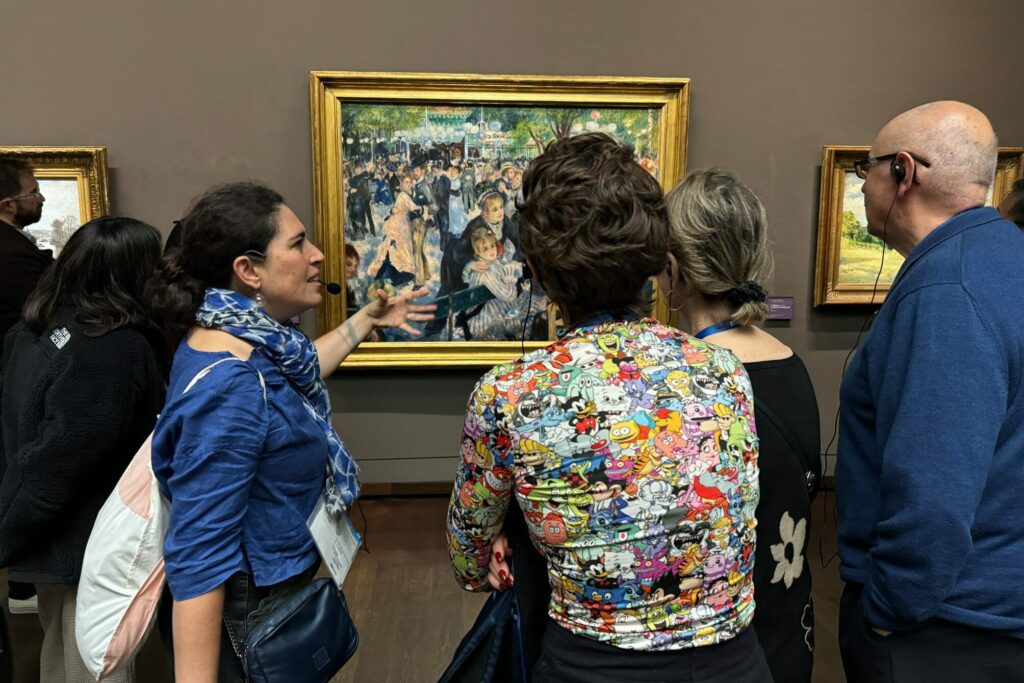
Over a couple of hours, she weaved a story that truly captured my attention.
She positioned the impressionists as the bad boys of their era who challenged norms and expectations in the Parisian art world, which was ruled by stuffy salons, to forge their own path and do what they wanted rather than what was expected of them.
Important note: Her tour DOES NOT include a ticket, so you will have to book a timed entry ticket for the time of the tour (she’ll give you more information on this).
If that tour isn’t available (she has limited availability because she does other tours of different aspects of Paris) then I’d do the Walks tour of the Musée d’Orsay, which gets good reviews (and is a tour company I trust based on my tours with them across Europe in Spain, Italy, and France).
As you make your way through the museum, you’ll get to enjoy some of the best impressionist art ever created. You’ll feast your eyes on Cézanne, Degas, Monet, Van Gogh, and many others.
If you visit on your own, make sure not to miss the Bal du Moulin de la Galette by Pierre-August Renoir with its energetic, lively atmosphere of a ball in Montmartre, Edouard Manet’s quizzical Olympia, Vincent Van Gogh’s Starry Night (if it’s on display), and Claude Monet’s Blue Water Lilies.
Though my favorite discovery was Pissarro, whose use of color captured my eye from across the room.
And the incredible use of light in Monet’s early La Pie (The Magpie), which depicts a winter landscape with sunlight poking through the bare trees and dancing across the snowy landscape.
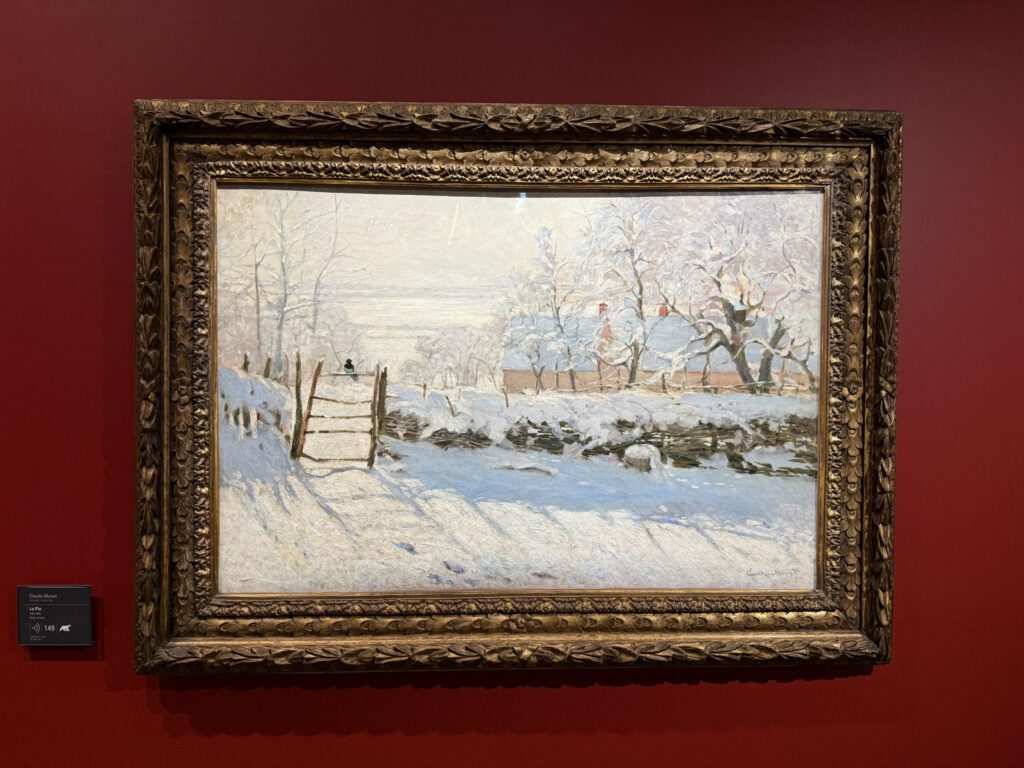
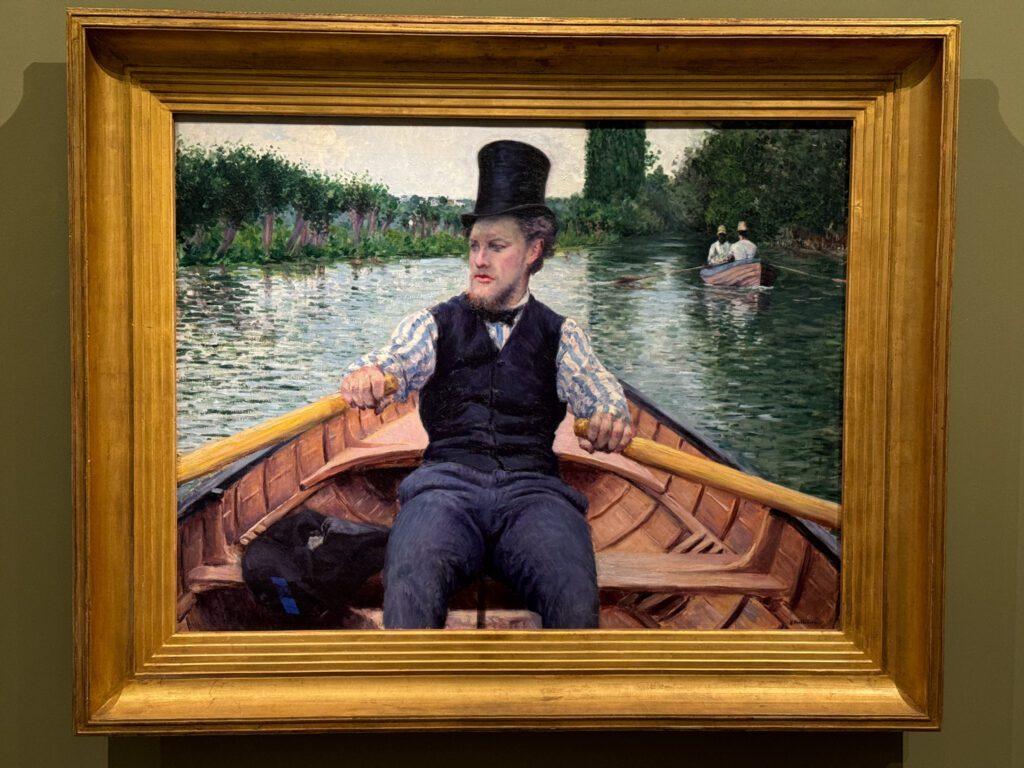
If you don’t do the tour with Carine, I highly recommend the audio guide to give you at least a little bit of the context and history. And book your tickets in advance to skip the ticket line!
How to Visit: As usual with the main attractions in Paris, it’s worth booking your visit in advance so that you can skip the ticket line (you’ll still have to wait in the security line). Make your reservation here. The museum is closed on Mondays. If you want a quieter visit, go on Thursday evening, when the museum is open until 9:45pm.
See the Eiffel Tower Up Close
Look, if we’re being completely honest, we don’t really think you should go to the top of the Eiffel Tower.
It reminds us a lot of the Space Needle in Matt’s hometown of Seattle in the sense that it’s expensive – in this case, both in terms of money and time – and it’s missing a key element of the skyline…the Eiffel Tower!
We have a couple of other suggestions for views of Paris that include the Eiffel Tower, and we would recommend skipping going to the top, instead focusing on the park at the base and the many views of the tower you can find from vantage points nearby.
There are two things we think you should do at the Eiffel Tower that are completely free.
The first is a picnic in the Champs de Mars, which is the park that’s at the base of the tower.
After the museum, stop by the best grocery store on the Left Bank – La Grande Épicerie de Paris (here on Google Maps) – for some fresh bread, cheese and charcuterie, and perhaps a bottle of wine or some beer.
Seriously, that grocery store is, yes, very fancy, but it’s a JOY to shop in and discover some new, interesting foods to try.
From there, it’s a short walk to the Eiffel Tower.
At the park at the foot of the Eiffel Tower, you’ll find a huge group of people enjoying the view on warm sunny days in Paris.
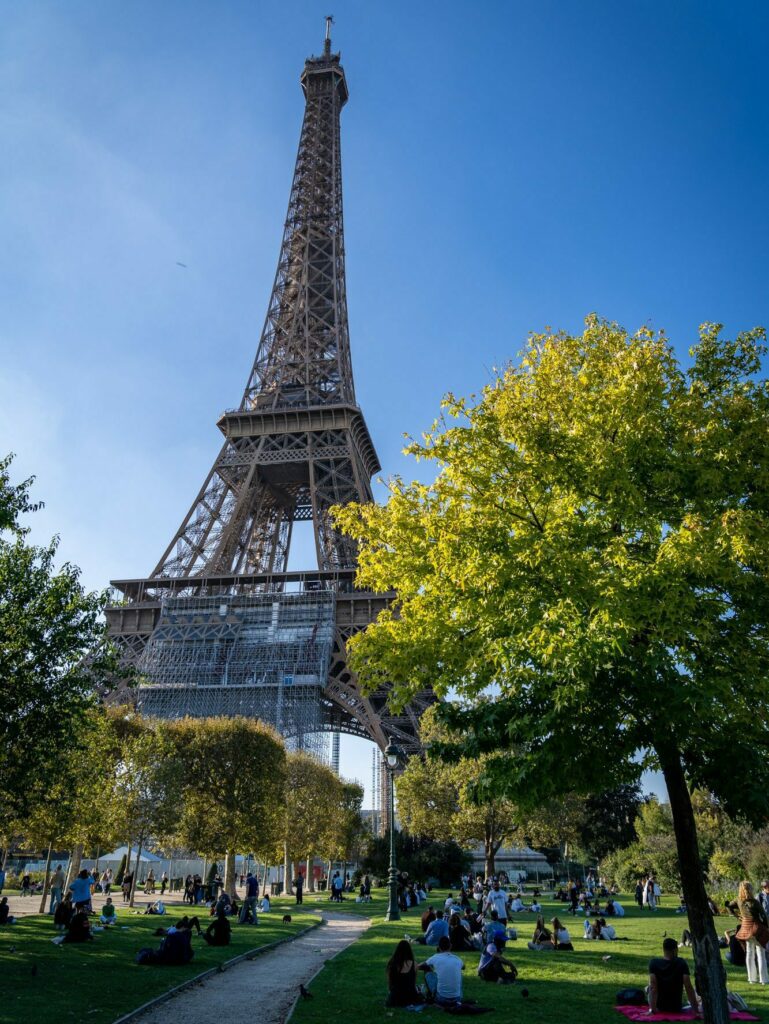
There’s some great people watching to be had here, including the people selling buckets of booze who have an intricate system designed to help them evade the police, who show up every once in a while.
The second thing we think you should do is walk over to the other side of the Seine, where you’ll find two worthwhile spots with excellent views of the Eiffel Tower.
First is the view from slightly above at the Jardins du Trocadéro (here on Google Maps). Second is the view of the Eiffel tower from the water level from here.

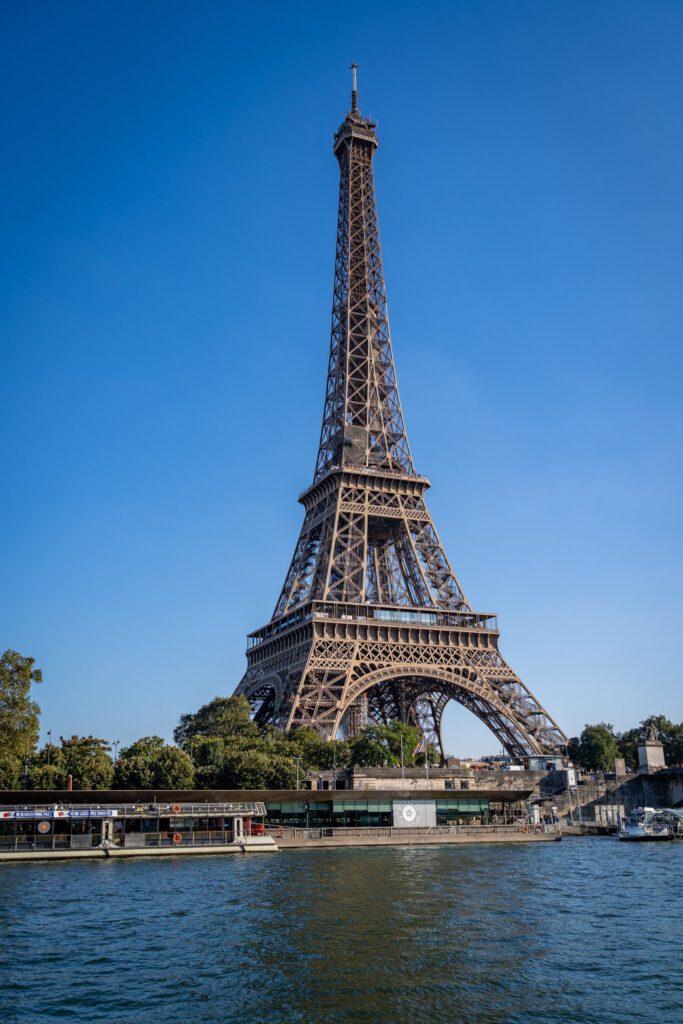
As you’re walking around the Champs de Mars, be aware of your surroundings. Pickpockets are common in this part of the city, and you want to keep an eye on your belongings (no phones or wallets in back pockets, people!).
The other thing to be aware of is the scams that are shell games and other informal gambling.
As you’re walking around, you’re likely to see multiple iterations of this phenomenon, and you should know that the games are rigged against you, and that there are more people involved in the scam than you think (including many of the other players.
In the grand scheme of things, we don’t think you need to spend that much time at the Eiffel Tower itself, and you’d be better off spending your time elsewhere.
We will say that it is worth seeing the light show that the Eiffel Tower puts on for five minutes at the top of every hour after dark (until 11pm, usually).
The start times change with the season – obviously, there are more hours after dark in the winter than in the summer – and this is a good reference to read. You’ll need to know what time the sun sets.
We’d watch it from the platform at the Jardins du Trocadéro just across the river, and you’ll want to be there a bit early to snag a spot.
But what if you want to go to the top?
Well, you have a few options to get to the top – you can take elevators to the second floor viewing deck or all the way to the top, or tackle it on foot up to the second floor platform, which involves more than 1,500 steps in total (and saves about 30% on tickets).
You’ll need to get tickets either way and we recommend booking tickets online to avoid huge lines at the ticket office.
Be prepared for long security lines at basically all times – “skip the line” means you skip the ticket line, but everyone has to go through the security line.
If you want to go all the way to the top, we’d book several weeks in advance because they do sell out.
Dive into the World of French Wine (with Erwan)
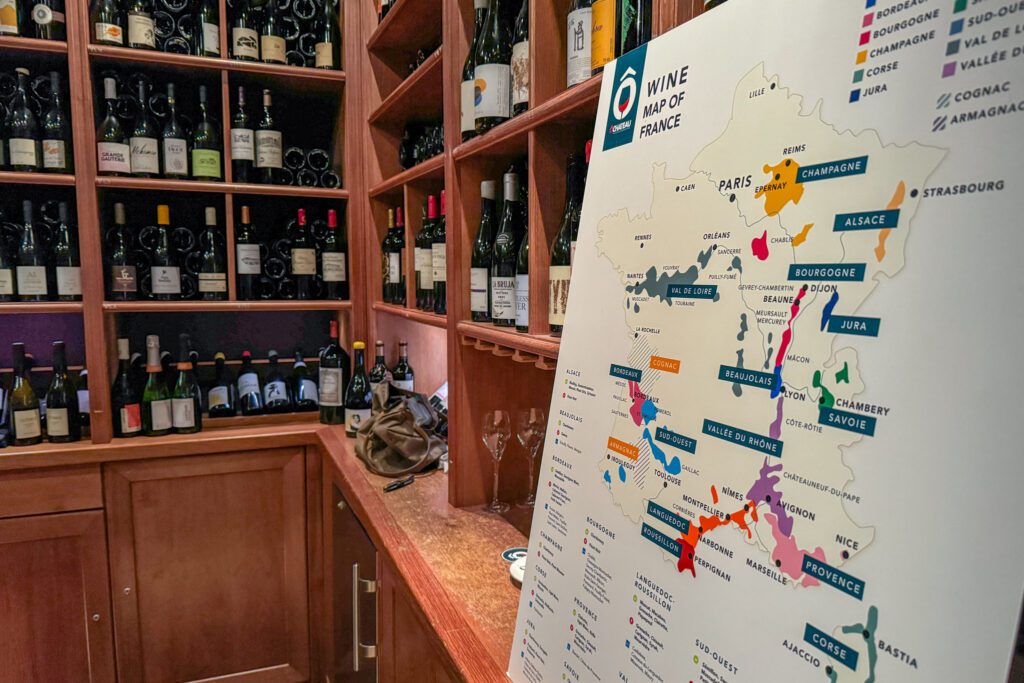
This is an important one for wine lovers. For a combination of many reasons, French wine just hits differently than wine from the new world.
My somewhat educated opinion is that it’s roughly equal parts centuries of farming and winemaking expertise and the fact that you’re on vacation, so everything just tastes a little bit better.
However, on my latest trip, I had a bit of a realization about wine in France.
It has to do with how wine lists are organized differently than we’re used to here in the U.S., and it means that many Americans on their first trip to Paris end up extremely confused when they sit down at their first dinner and try to order wine.
The reason? There is not a single mention of wine varietals on a French wine list.
In the U.S., when you go to order wine, you’re generally ordering it by varietal, like Cabernet Sauvignon or Sauvignon Blanc.
In France, things are organized by region and even city, without a single mention of what grape you’re ordering.
In fact, if you look at a typical French wine list, you will not see a single mention of a grape varietal.
The reason is actually fairly simple (though I still think it would be helpful to know the grape varietals too!): The French believe in the concept of terroir.
The idea here is that the soil, elevation, and climate of the place imparts inherent characteristics on the wine, and that a grape varietal grown in, say, Australia is going to taste different from the same varietal grown in France.
The idea of place is the most important thing that creates the wine in the bottle, so that’s what they lead with.
However, if you’re coming from our American paradigm and approach, it’s extremely confusing, because how the heck am I supposed to know what the wine in Sancerre or Bourgogne is like?
Well, you have to taste them!
If you care about finding what kinds of French wine you like (and what you don’t) and aren’t already familiar with French wine, I highly recommend investing in a wine tasting experience where an expert walks you through the main wine regions in France, and guides you through a tasting of them.
If you want to make sure to drink great wine during your trip, I’d highly recommend scheduling one of those experiences for your first night to set you up for success for the rest of your trip.
I know this, because I did two on my latest trip, and despite being generally familiar with a couple of regions, I learned that I like wines from Sancerre (sauvignon blanc), other whites from the Loire Valley (like the chenin blanc from Saumur), and that I can get on board with reds from Languedoc.
I did two tastings, and they turned out to be fairly different approaches to the same thing.
The first was this tasting at a wine bar in the 1st, which was led by a sommelier and was a little more heavy on the educational piece (though still very interesting and engaging!). They also have an earlier time slot if you want a lunchtime wine extravaganza.
The second was a wine and cheese tasting in the 7th with Erwan, which was much more casual and low key (and I really enjoyed Erwan’s story and approach!).
He pairs five wines with five French cheeses, all of which were excellent.
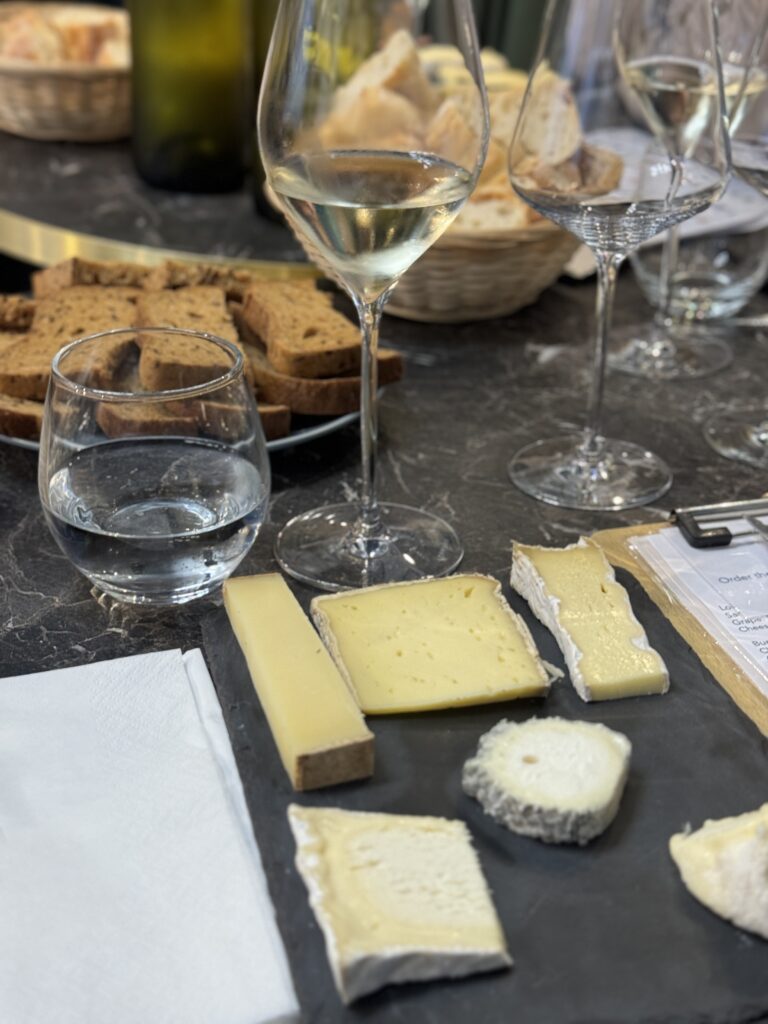
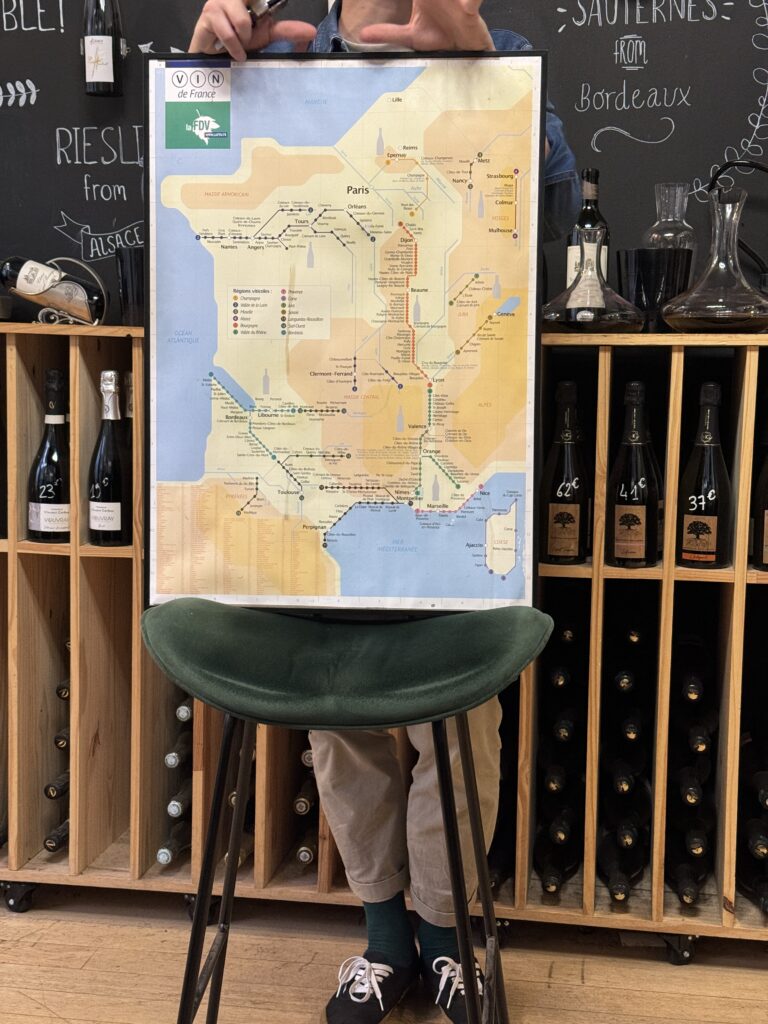
I enjoyed both (and the wines were all great), and it comes down to what kind of approach you’re looking for.
For the purposes of this itinerary, though, I’d highly recommend Erwan’s session because it is right near the Eiffel Tower, making it an easy addition to your first evening either before or after the tower (it depends on the time of year).
Day 2: Île de la Cité and the Right Bank
On your second day, when you’ll ideally be a little more well rested, bright eyed, and bushy tailed, head to the right bank for an action-packed day.
But First, Coffee
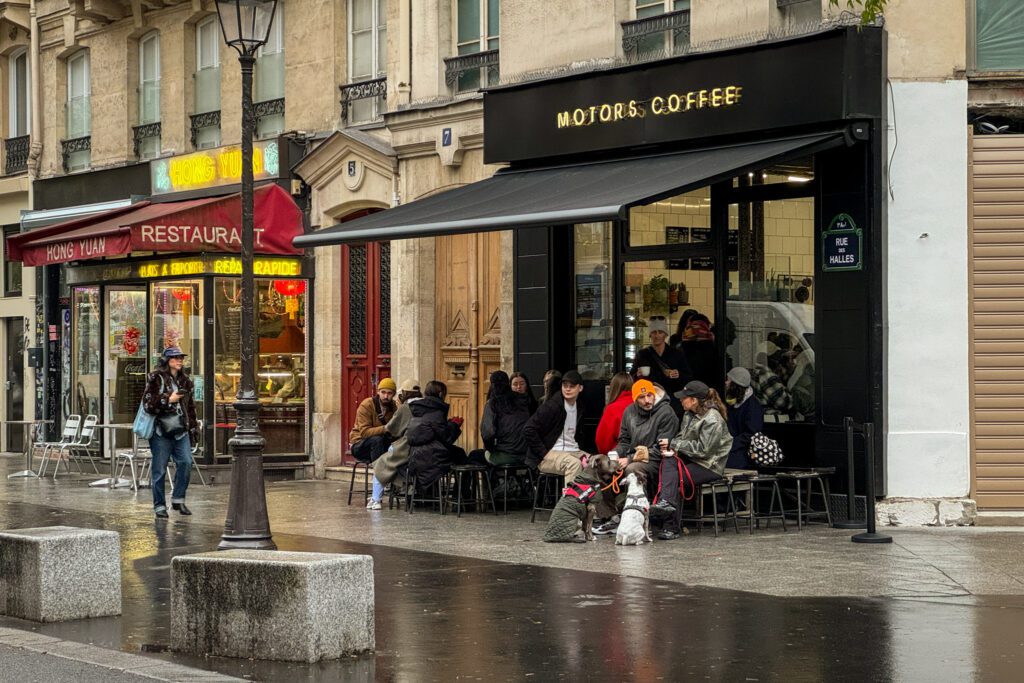
The area near Île de la Cité is home to a couple of my favorite coffee shops in Paris, but Motors Coffee would be my top choice for starting your day off with good coffee and a delicious homemade pastry.
It’s a five minute walk or so to Notre Dame and Sainte-Chappelle, and they bring in some of the best coffees from around the world to brew at their compact shop on the border of Le Marais and the 1st Arrondissement.
I came here multiple times on my latest trip to Paris, and I was sitting at the seat next to the stairs, where cinnamon and other baking spices were wafting up from the kitchen below.
Grab a coffee, a pastry, and a seat on their terrace out front to set yourself up for an action-packed day ahead.
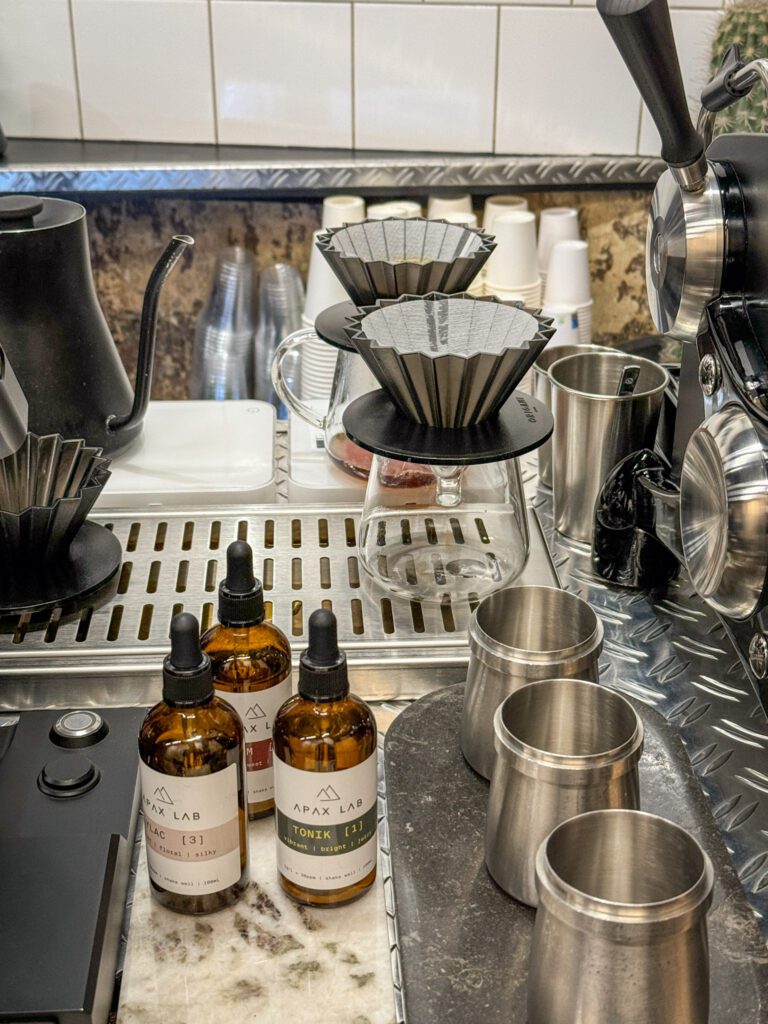
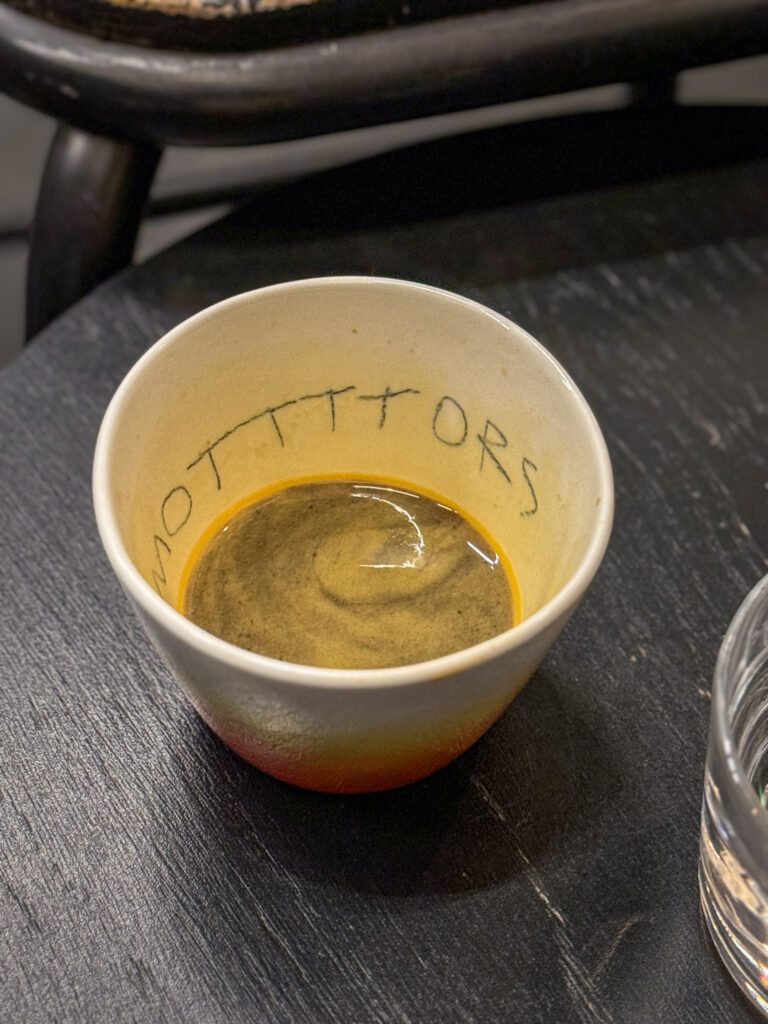
Île de la Cité and a Tale of Two Churches
The relatively small island in the middle of the Seine – which is a natural island, it isn’t man made – is where you’ll find two of Paris’ best and most well known churches.
One is the religious center of the city, and the other is the former royal chapel that, today, is my personal favorite church in the world (aside from la Sagrada Familia in Barcelona, which is a masterpiece).
Notre Dame de Paris
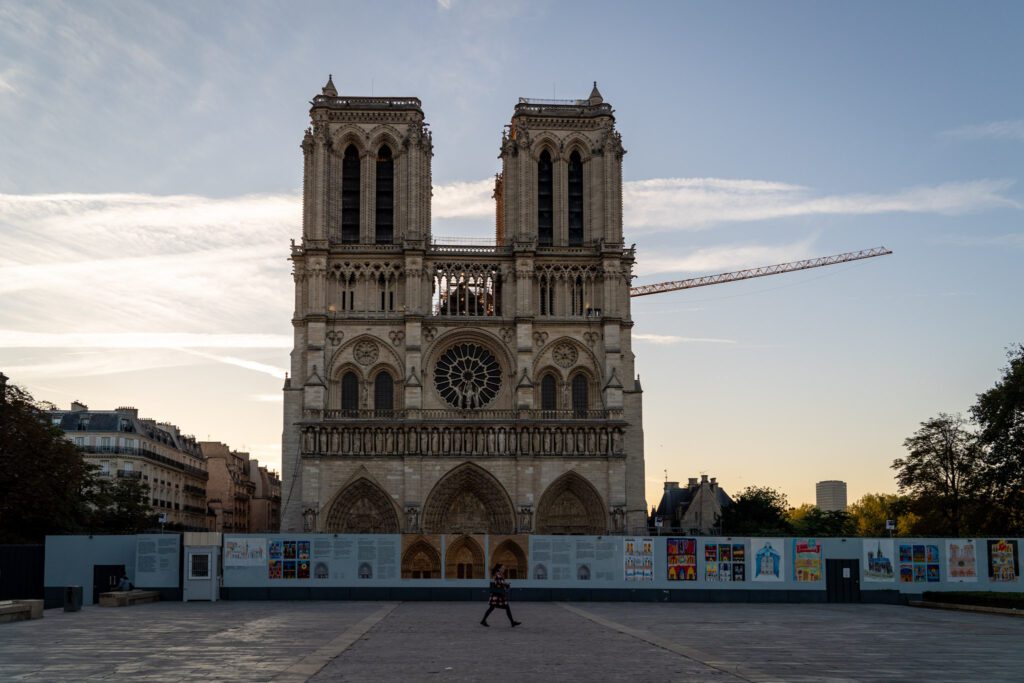
Let’s start with the former – Notre Dame Cathedral – which is arguably one of the most famous churches in the world.
Construction on Notre Dame began in the 12th century, and it has gone through several iterations to get to where it is today.
It’s an example of Gothic architecture (French Gothic, to be specific), and it’s worth walking along the river on either side to see the grandeur of the building from the outside (and those beautiful flying buttresses!).
Now, you might know that Notre Dame suffered a terrible fire in 2019 (you may remember all the social media posts showing their love for the church), and has been closed ever since as it was restored.
I’m here in Paris in the weeks before it opens back up, and every local I’ve talked to has expressed excitement.
It’s a magnificent church, with great stained glass (though, sadly, it will be mostly replicas as a result of the fire), and I would recommend going up to the bell towers if you can for the views over Paris AND the excellent views of the gargoyles, which play an important role in the Disney masterpiece The Hunchback of Notre Dame (the song “Hellfire” is still a banger).
How to Visit: Great news, it’s FREE to visit Notre Dame and go inside. However, you will have to make a timed reservation, which will almost certainly be competitive. More information here.
Sainte-Chapelle
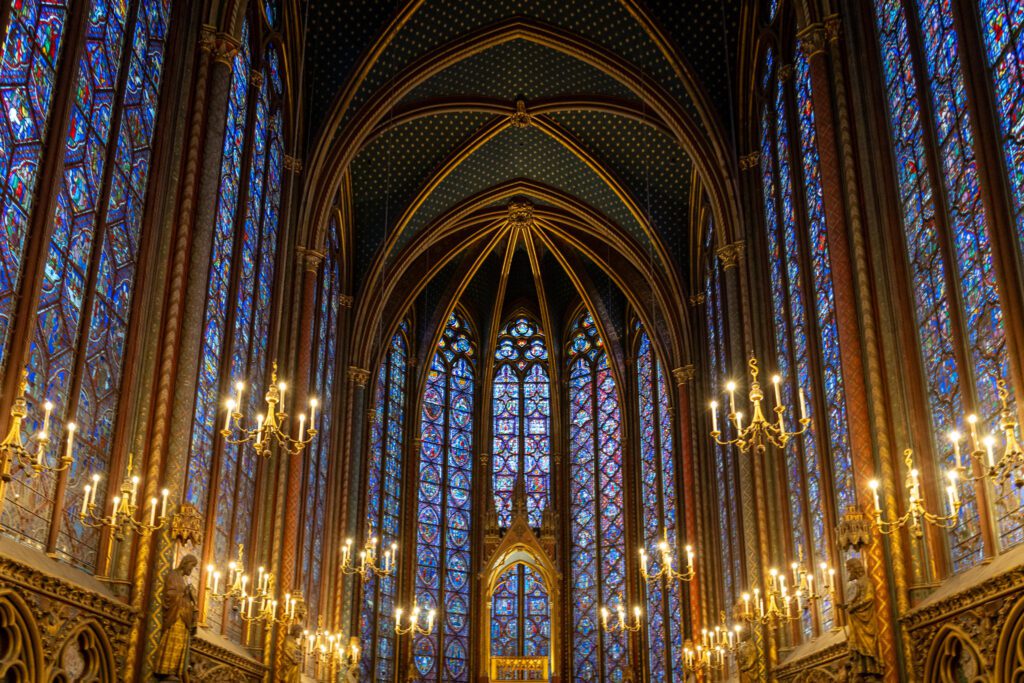
Until I revisited Sainte-Chapelle on this past visit to Paris, I forgot just how impressive the main chapel really is, with its 1,000+ colorful stained glass panels depicting scenes from the bible (don’t miss the helpful visual guide that’s inside the chapel, which will help you decode what you’re looking at).
What is Sainte-Chapelle, you ask?
It’s the Royal Chapel that sat within the Palais de la Cité, the medieval palace that resided on the island in the middle of the Seine for a few hundred years until the kings decided to move elsewhere (somewhere safer after a few close calls with rebellions, something the French love to do!).
The most impressive part about the story of the Chapel, at least to me, is the fact that it went from an idea to finished in less than a decade (while Notre Dame, which is of course much bigger, took more than a century).
It’s a relatively quick visit – there’s basically only one room to see here – but it’s well worth braving the crowds, I think. I’ve done it three times now, and I will probably do it again in a few years.
It’s absolutely best on a sunny day around midday, when the sun reaches over the walls of the building surrounding the chapel and lights up the stained glass, but I was here on a dreary November morning when the chandeliers had to be lit because it was so dark, and I still enjoyed it.
How to Visit: This one is not free, and I HIGHLY recommend making a timed entry reservation in advance (usually a week or two in advance is fine – it does sell out).
Like many attractions in Paris, there are two lines to get into Sainte-Chapelle: the security line, and the ticket office line.
By buying tickets in advance, you get to skip the second one, and you’ll just have to line up for the security check (no big bags or luggage allowed, and nowhere to leave it).
You can pay a few extra Euros for an audio guide, but I didn’t think it was worth it here (and I usually love audio guides). Make your reservation here.
Lunch and Coffee in the 1st
After exploring the two churches, head over to the 1st Arrondissement, near the Louvre, for lunch and a little caffeine boost before you tackle the hefty museum that the district gets its name from.
The reason to head here, specifically, for lunch is the fact that the area just north of the Louvre is known for its Japanese food, which I only realized and looked into after walking along Rue Sainte Anne (here on Google Maps) on my way to the coffee shop below.
I asked a guide about this, and he had a few recommendations in the area. First is Kintaro for ramen. Second is Udon Jube. Last is You.
I need to eat gluten free, so Japanese food is very difficult, generally speaking. However, there’s a 100% gluten free Japanese lunch spot called Cococo that I absolutely adore.

For coffee, head straight to Télescope Cafe where you’ll find a compact space and excellent coffee featuring coffee from Scandinavian roasters (mostly).
Télescope is one of the OG specialty coffee shops in Paris – an oasis of light, bright coffees in a city where that was exceedingly rare a decade ago – and its location on a relatively quiet alley a short walk from the hustle and bustle of the Louvre only accentuates the “oasis” idea.
I’ve been here many times now, and it was actually the first place that made me realize you could brew great coffee using an Aeropress.
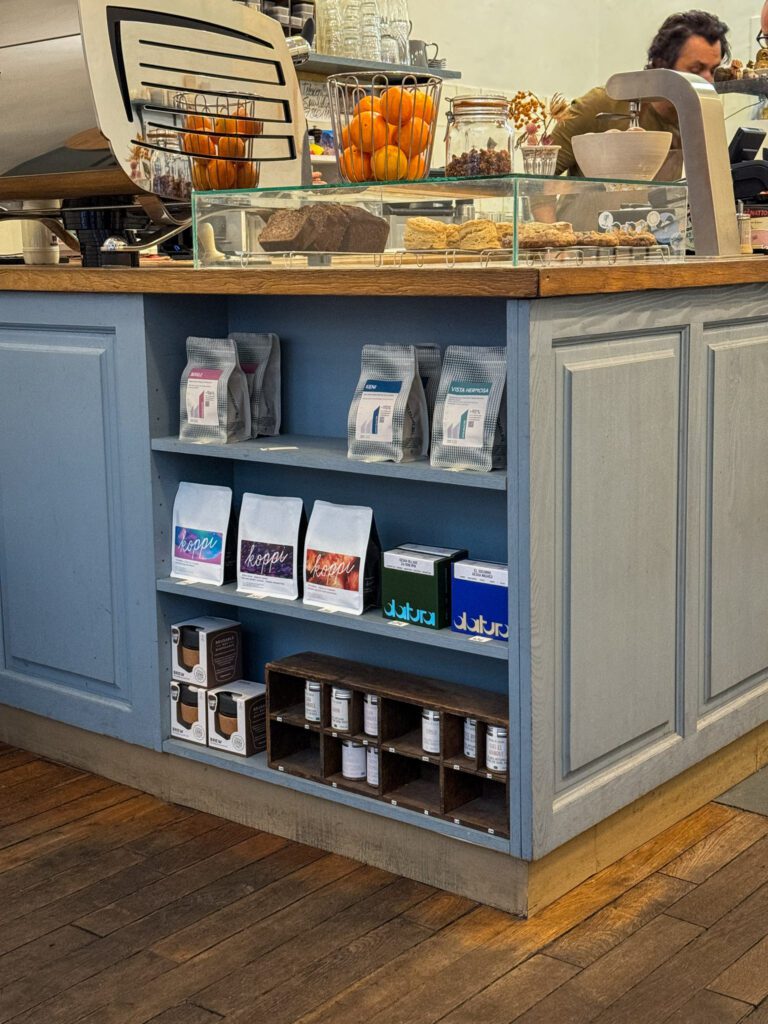
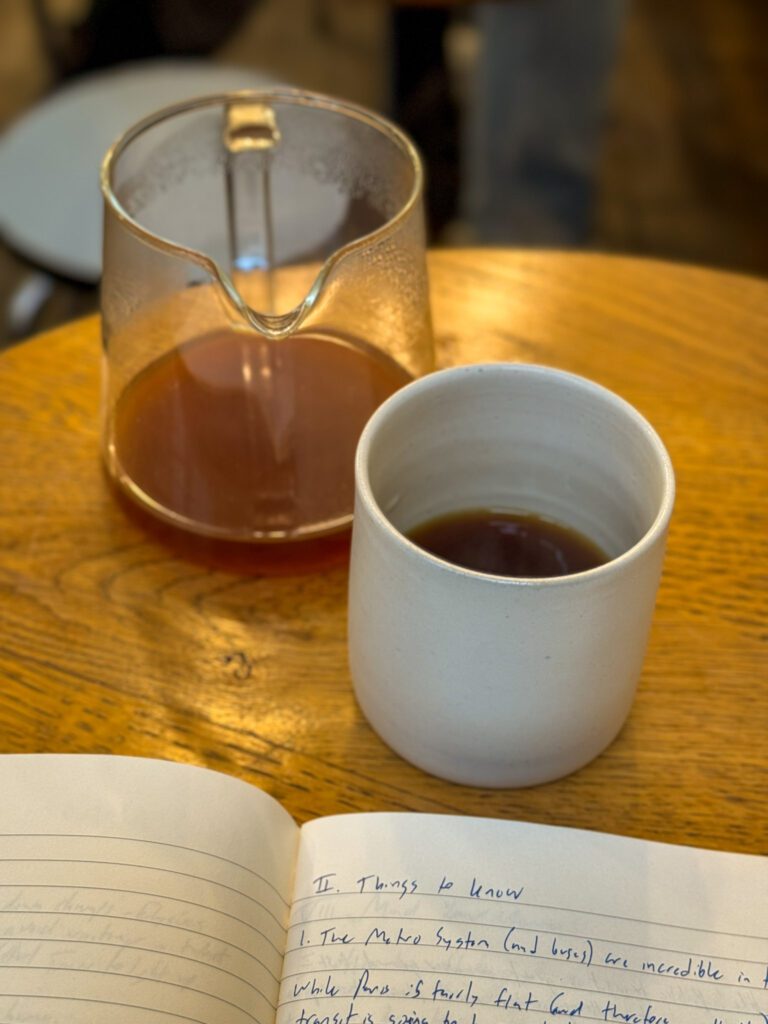
One other thing to note here: It’s a very small space, and they have strict rules about laptops (no laptops), where you should sit, and about how many drinks you need to order (at least one per person) to maximize the amount of people they can serve. Also, they prefer cash under €5, and will add an upcharge for cards under that limit.
The Louvre
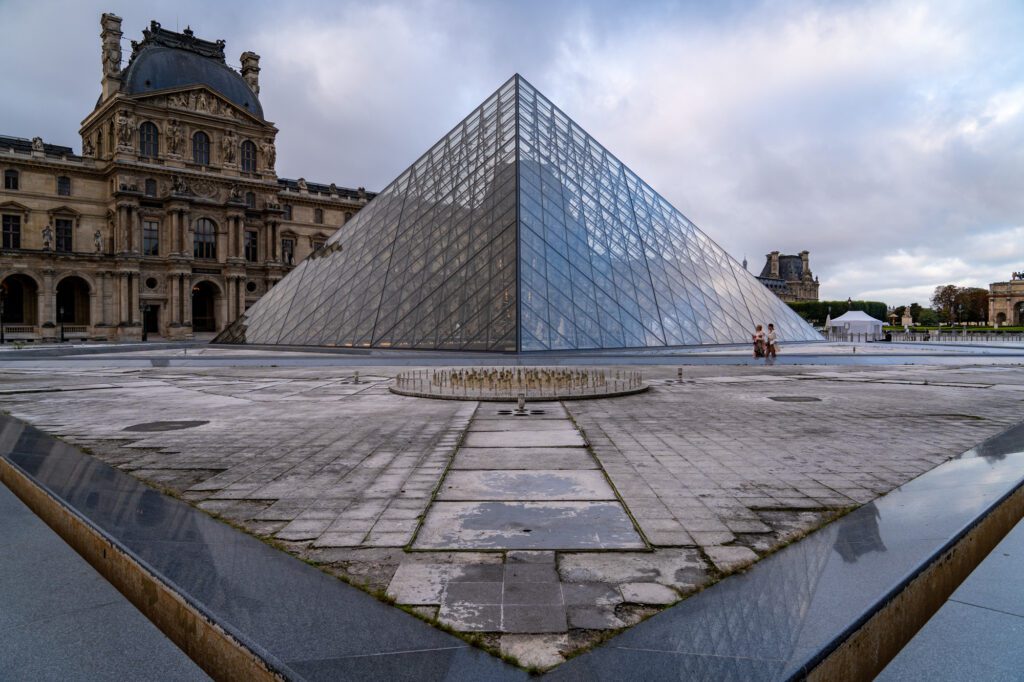
Before we get into the main part of this section, let’s take a step back and talk about the Louvre as a tourist attraction.
It might be the most famous tourist attraction in Paris (maybe second after the Eiffel Tower), but our feelings on the Louvre are slightly mixed.
On one hand, this is one of the most impressive art collections on the planet, with an incredible breadth and depth of art – and by extension, important moments in art history – within its walls.
On the other hand, it’s a MASSIVE museum that would take days, if not weeks, to fully see.
But as you likely already know, you don’t have days or weeks, you have a portion of one day.
Our recommendation is to spend no more than three to four hours in the Louvre.
That gives you enough time to see the highlights (more on this in a second) and wander a bit, but doesn’t have you spending a whole day inside the vast museum.
Of course, this is all going to depend on your appetite for museums and how much of your precious time in Paris you want to spend wandering around the Louvre.
If you want to spend a full day doing that, by all means go for it! You’ll probably have to make a few cuts and changes to the rest of your itinerary.
Now, let’s talk about the museum itself.
The building that the Louvre currently lives in was originally a military building (though it was called a palace) to protect Paris’ western flank, and later became a royal palace.
It was turned into a museum for the people during the French Revolution in the late 18th century, and has been open to the public ever since.
In the basement of the Louvre you can actually still see the restored sections of the walls of the original building, which looks very much like the walls of a castle.
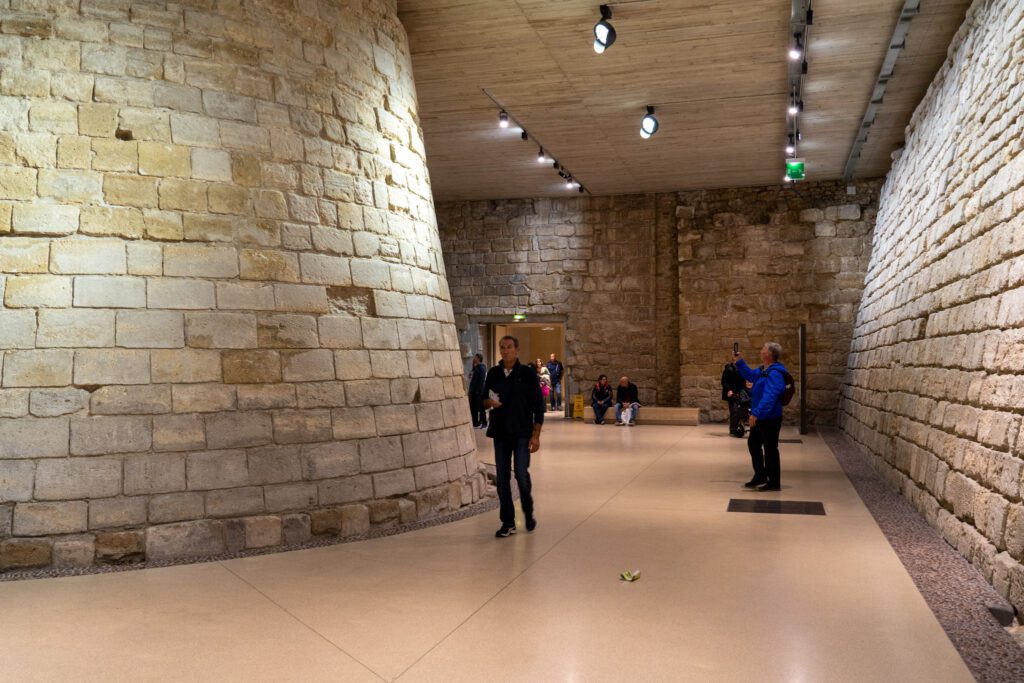
The Louvre’s collection is MASSIVE, with representation from basically every corner of the globe.
The most famous is, of course, Da Vinci’s Mona Lisa, but you should absolutely set your expectations when it comes to viewing her.
The room where the (surprisingly small) painting lives is almost always unbearably crowded, with people essentially crowd surfing to get to the front to take their precious picture (what the heck are you even going to do with that picture? You’re never going to look at it again!).
Definitely be sure to look at the other paintings in that room, because there are some good ones at the backs of all the people trying to get a closer look at the Mona Lisa.
Here are some other highlights that we would make sure not to miss: The Winged Victory (which is supposedly the inspiration for the famous Nike swoosh), the French paintings (like Liberty Leading the People and the Raft of Medusa, Crowning of Napoleon) and the iconic Venus de Milo.
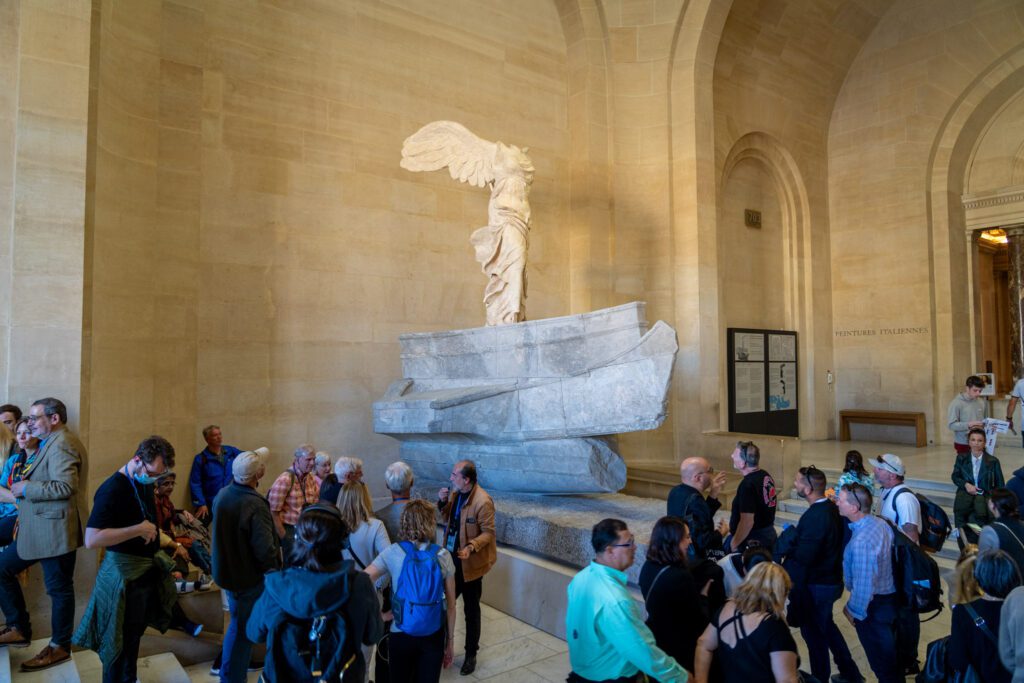
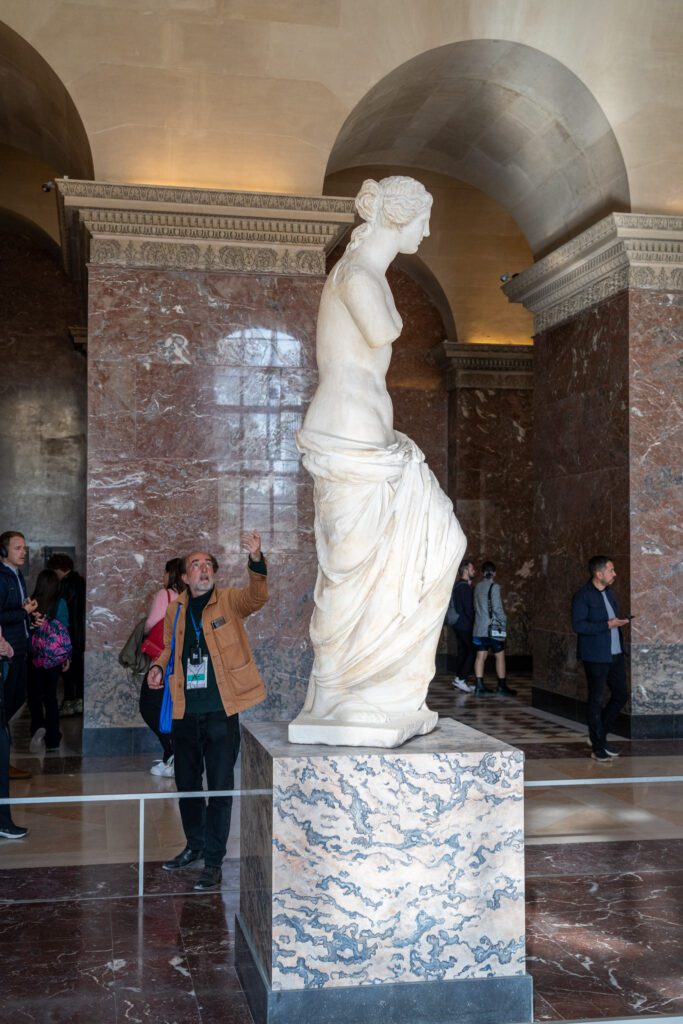
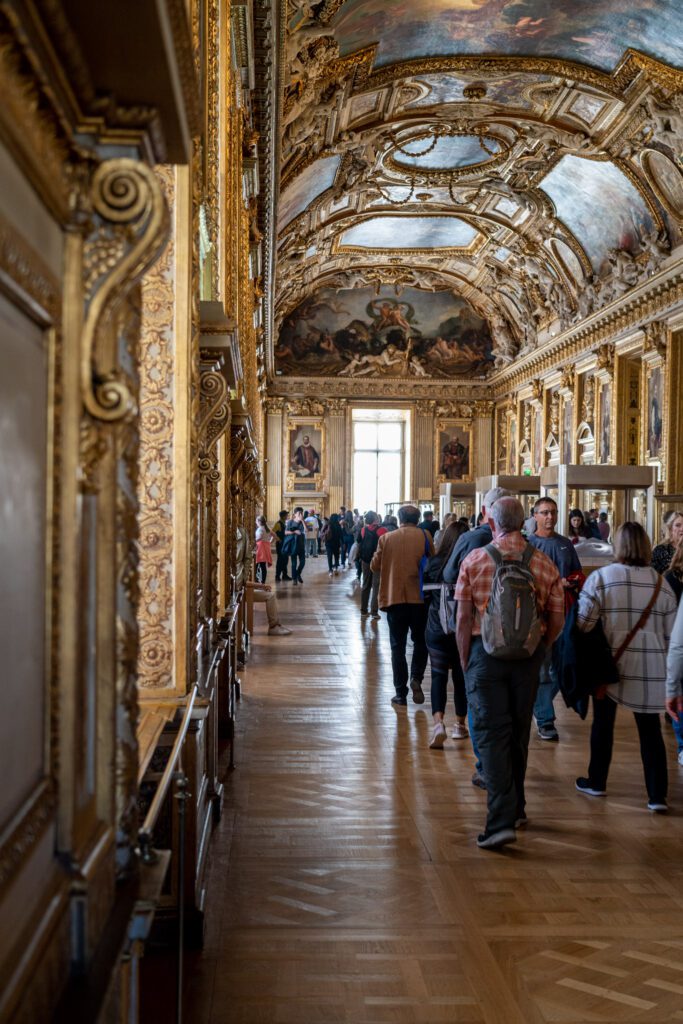
There are, of course, thousands of other “highlights” that we could list here, but those are the ones that stand out to us.
A Note on Timing: The afternoon is generally the best time to visit the Louvre for slightly more manageable crowds. The late afternoon / early evening will give you a marginally more peaceful experience, which is why we’ve organized the itinerary in this particular way.
Another important note: The museum is closed on Tuesdays, so plan accordingly. Make sure to review their bag policies (which you can find on their FAQ’s) because big bags are not allowed in the museum.
Visiting the Louvre on a Guided Tour
On our three month European adventure that took us to Italy, Spain, Portugal, and Paris, we had the chance to see multiple famous art museums.
We quickly realized that we’re just not really art museum people. But after a tour of the Uffizi Gallery in Florence, I had an epiphany as to why.
Walking around an art museum and looking at pretty paintings is cool and all, but the real pleasure is when you actually understand the story behind each work of art, and the role they played in history and the progression of art history.
Which, as two normal people, is something we don’t really have in our repertoire.
We highly, highly recommend investing in a guided tour of the Louvre.
We’ve both done it independently – Matt multiple times – and have come to realize that unless you’re an art historian, it’s really, really hard to visit a huge art museum independently and come away with much else than “well that was pretty” or “whoa, they have so much art!”
A guided tour with an art historian is going to give you the context and stories behind each work of art, which are the things that really bring the experience to life.
Plus, arguably more importantly, they’re going to help you understand the important pieces and periods to focus on.
I, Matt, have now done the Louvre three times, twice without a guide and once with a guide, and my experience with a guide brought a level of richness and understanding that I absolutely would have never gotten on my own.
If you’ve only got the time or budget for a single guided tour in Paris, this should be your choice.
I (Matt again) recently did this tour of the Louvre at closing time with Walks – a company I’ve done six or seven tours in Europe with, and really loved it. You can read more about my experience here.
I truly think this tour was worth the time and money for the multiple reasons I listed above.
Visiting the Louvre Independently
If a tour isn’t in the budget (or doesn’t fit with your timing), we have a few thoughts on how to maximize your time and pleasure at the Louvre.
First, absolutely book your tickets well in advance for a timed entry slot, which will allow you to skip the ticket office line and head straight to the security line, which everyone has to wait in (but at least you don’t have to wait in two long lines!).
You’ll want to book your tickets a few months in advance. You can book tickets here.
Second, if you have pre-booked tickets, you can enter through a “secret” entrance (but how secret can it be if it’s listed on the Louvre’s website?) that sees far less crowds called “Porte des Lions.”
You can find it here on Google Maps. This does mean that you don’t go through the iconic entrance in the glass pyramid, but could literally save you an hour of your precious time.
Third, we’d recommend either an afternoon visit (2pm or so), or taking advantage of the late night openings (currently Wednesday and Friday at the time of writing), when the museum is open late (until 9pm) and the crowds are much, much thinner.
It will require a bit of rearranging, but it will be well worth it.
Last, we think the audio guide is worth it, and is a good alternative to a guided tour that will give you a little bit more context and history around the works of art you’re looking at.
Make sure to review their bag policies (which you can find on their FAQ’s) because big bags are not allowed in the museum.
A Post-Museum Walk Through the Gardens
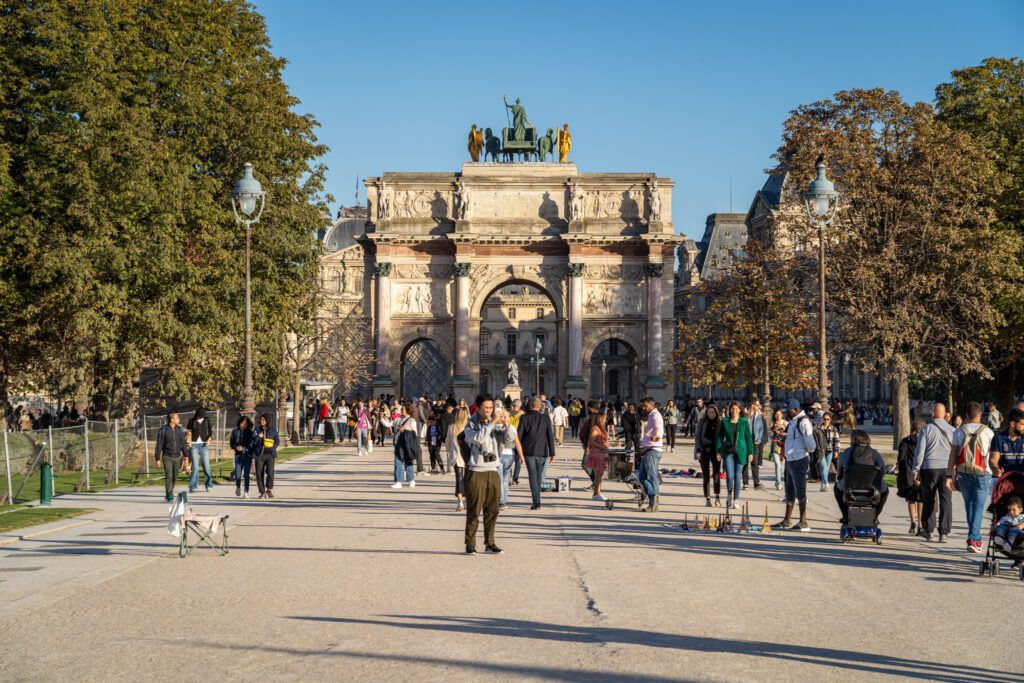
After a few hours at the Louvre, clear your head a little bit with a nice walk through the Tuileries with a couple of quick detours en route to the famous Champs-Élysées, the ultimate example of the grand Parisian boulevards of Napoleon III’s dreams.
The Champs-Élysées are pretty “meh” for us – it’s lined with the exact same kinds of shops and stores you’d see anywhere else in the world, and it really isn’t all that charming or interesting.
If you want to go to a Zara, Five Guys, or an H&M, we’d do it at home and save your precious time in Paris for something else.
Anyway, from the Louvre, walk west and you’ll immediately be in the Tuileries, passing under one of two triumphal arches built by Napoleon that you’ll see this afternoon (you’ll go to the top of the second!).
Here are our favorite stops on your walk along the Right Bank, which as you’ll see was the home of the nobility and aristocracy in Paris for centuries.
- Take a detour out of the gardens to the Jardin du Palais Royal – another beautiful garden in the heart of the city, built around the 17th century Royal Palace. A great place to stop and smell the roses (literally!). This is the palace that King Louis XIV abandoned (and gave to his little brother) when he moved out of the city to Versailles.
- Continue the detour over to Place de la Vendôme, where you’ll find another Napoleonic relic in the center, surrounded by storefronts for many of the most famous French fashion brands in the world (Dior and Chanel have locations here, for example). The column in the center is dedicated to Napoleon, who is depicted as a Roman emperor at the top, and has depictions of many of his accomplishments winding around all the way to the top. Fun fact: it’s made up of melted down cannons from the Austrians that Napoleon beat at Austerlitz, one of his most famous military victories in his illustrious military career.
- Head back out towards the rivers back to the Tuileries Gardens, where Parisians enjoy sitting on the lounge chairs by the fountains (there are pairs of lounge chairs that are welded together facing each other, which I thought was kind of cute) or taking walks with their friends. Cross it from the Louvre to the Place de la Concorde to end up in the wide square with the Obelisk (it is 3,300 years old and engraved with Egyptian hieroglyphics).
- Carrying on along the Seine you’ll find the Grand Palais – built for the 1900 World’s Fair, it is home to several exhibitions. Check out the amazing 8.5-ton art nouveau glass roof!
- Finish your walk on the Champs-Élysées, strolling towards the Arc de Triomphe.
Here’s a map of a route that hits the stops above.
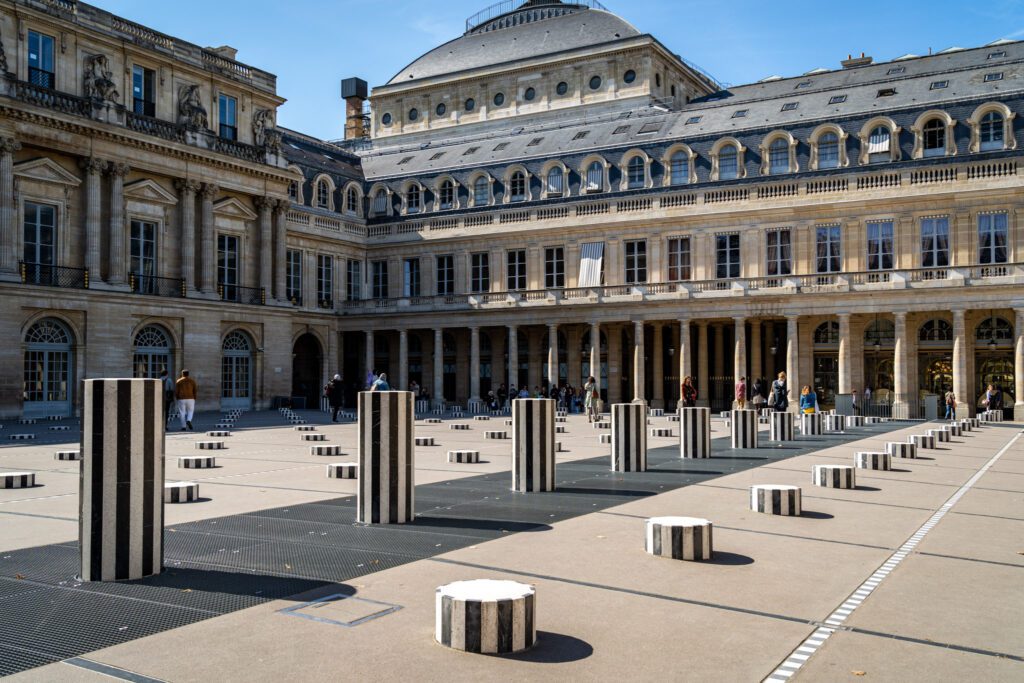
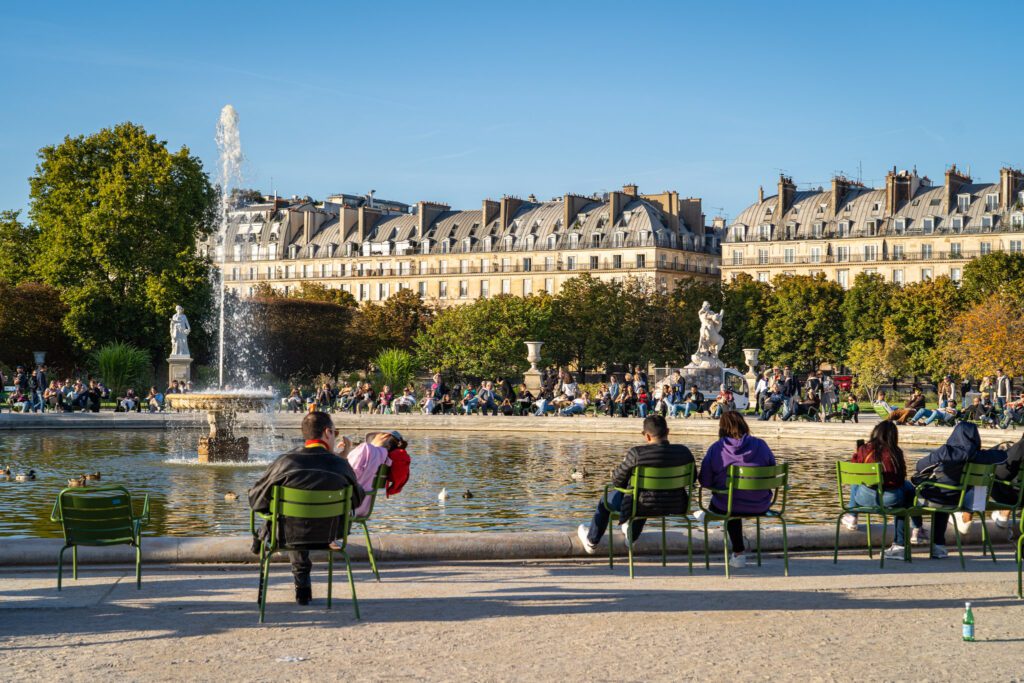
Climb the Arc de Triomphe
Close out your day in Paris with a trip to the top of the Arc de Triomphe, which was built by Napoleon in the early 19th century to commemorate a victory at Austerlitz. Napoleon LOVED his triumphal arches.
A quick side note: If you’re interested in Napoleonic history, I have a recommendation for you.
At the beginning of our latest three month trip to Europe that took us to Spain, Portugal, and Italy, we heard Napoleon’s name over and over, and to be honest, the only things I really knew about him were that he was short (which isn’t true) and spoke French in a funny way (because he wasn’t a native speaker – he was Corsican).
So, to learn about the man who shaped modern Europe in many ways, I started listening to this podcast about Napoleon, and I love it. It’s a deep dive into Napoleon’s life and impact on Europe during his brief stint at the top.
Now back to your regularly scheduled programming.
Continue all the way up to the Place de l’Étoile, where you’ll be looking up at the Arc from below.
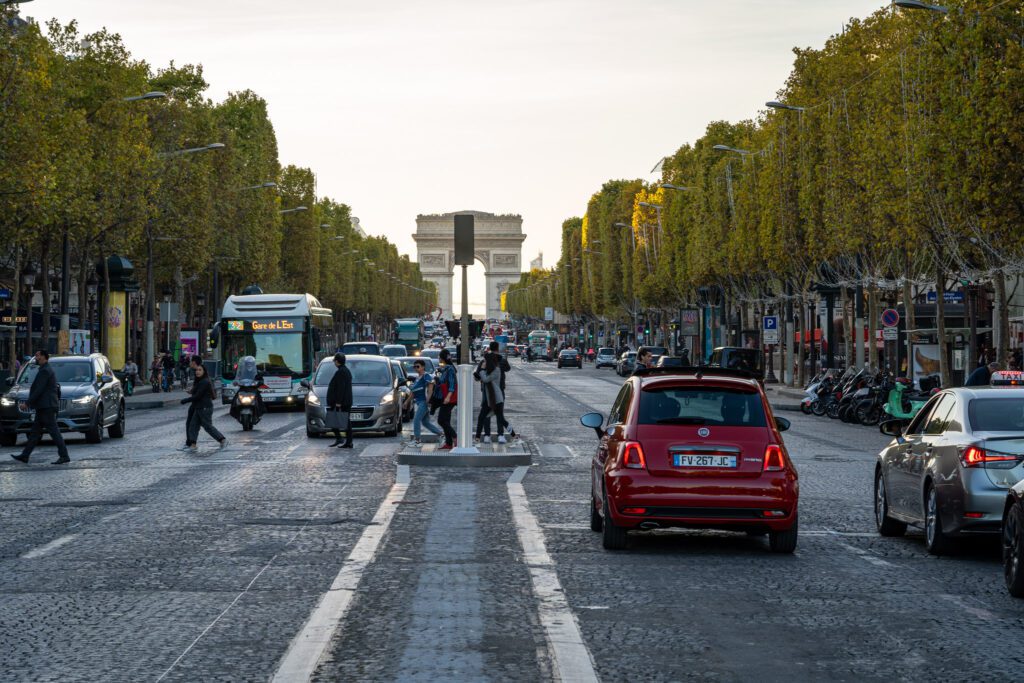
The Arc de Triomphe can be reached through an underpass from the northern side of the Champs-Élysées, bringing you to just underneath the arch.
Go around sunset for soft golden light washing over the sprawling city, and stay for a bit when the lights come on, and you’ll understand how Paris got the nickname “City of Lights.”
This is hands down my favorite view in Paris, and I’d say it’s a must-visit on just about every version of an itinerary.
Particularly if you come around sunset and stay until the city lights up, which is what I did (although it’s easier to do in November, when I was last in Paris, when the sun was setting around 5pm).
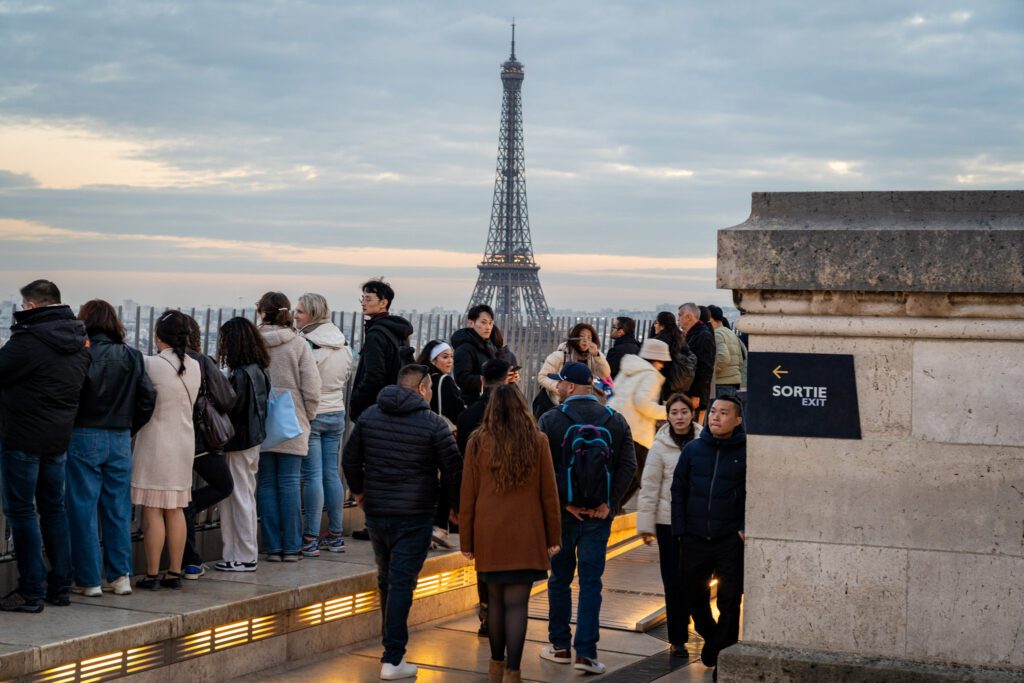
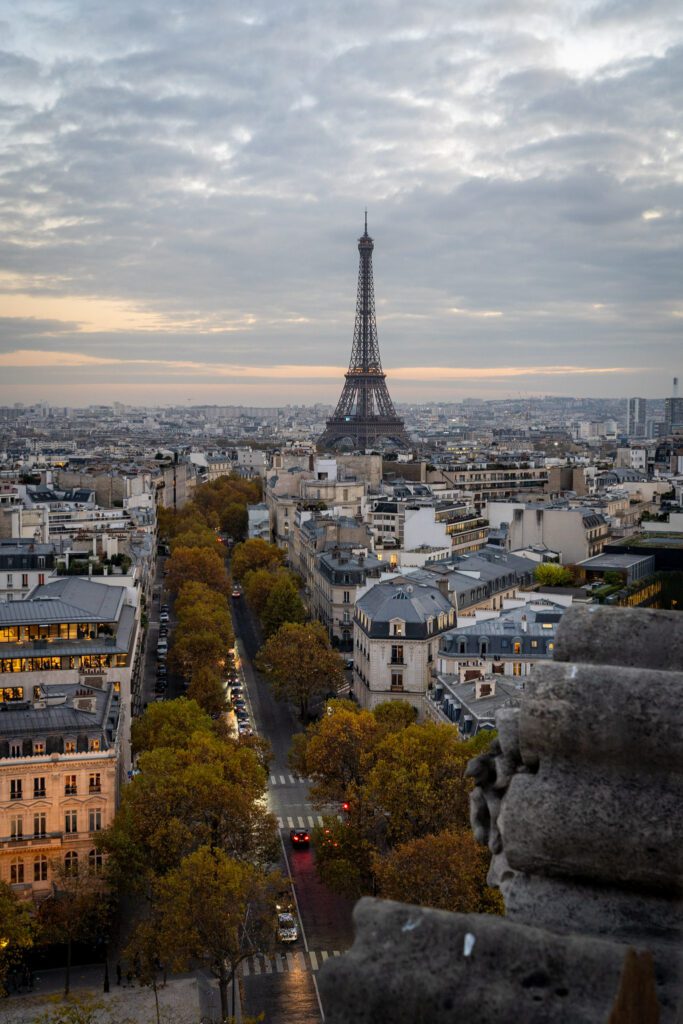
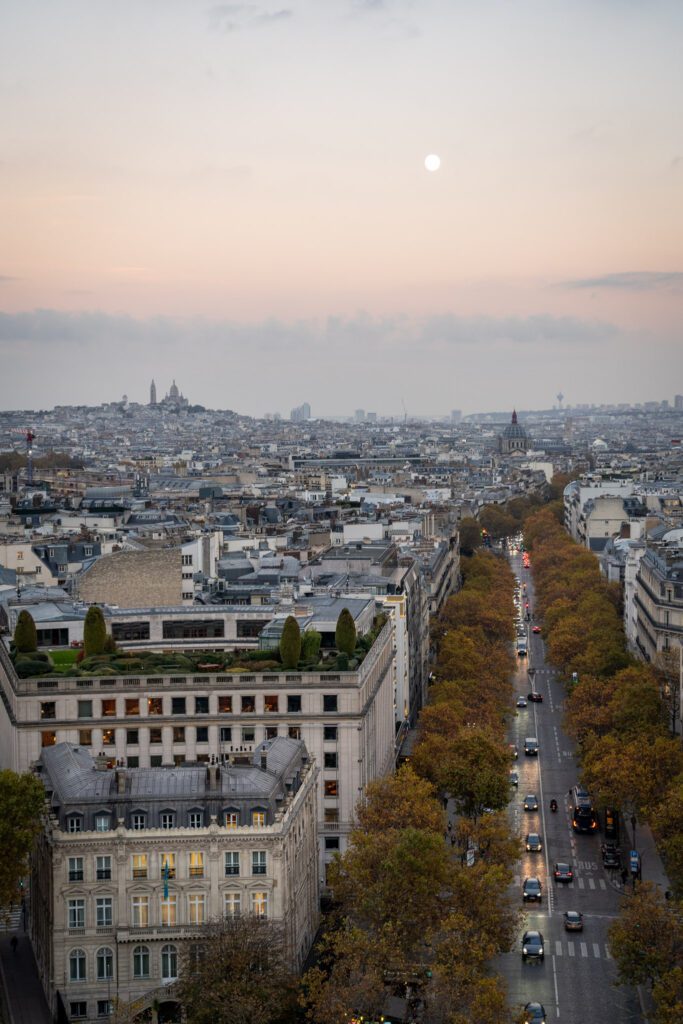
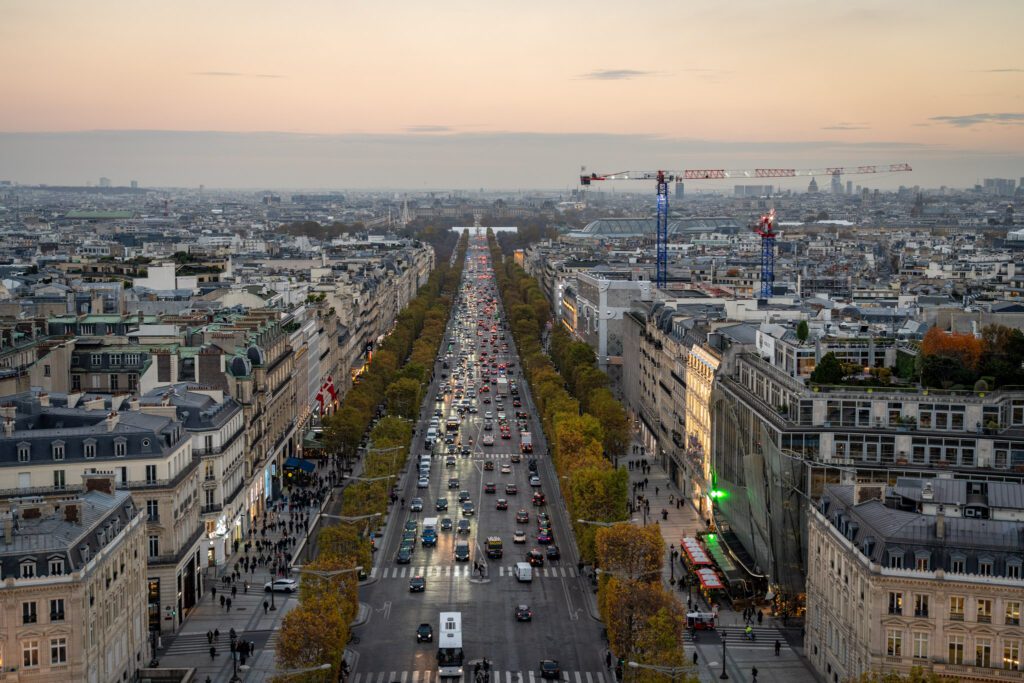
You’ll then climb 284 stairs en route to the terrace and viewing platform at the top (there are a couple of additional interior stops on the way up with information about the arc and its construction).
From the terrace, you have a 360 degree view of Paris, including down the
Champs-Élysées, towards the Eiffel Tower, and over towards Sacré-Cœur and Montmartre. It’s a special view, and is well worth the price of admission (we think).
How to Visit: Again, it’s worth booking your visit in advance so that you can skip the ticket line (you’ll still have to wait in the security line).
Make your reservation here.
You’re going to have to climb a winding staircase (with 284 steps) to get up to the terrace with the views (there is an elevator, but it should only be used by people who need it).
Along the way, there is an interior floor with a nice display about the history and construction of the Arc. Leave bags bigger than a small backpack at home, because they’re not allowed.
Day 3: Le Marais, A Foodie Adventure, and Montmartre
On your third day in Paris, spend your time exploring two of our favorite neighborhoods in Paris – Le Marais and Montmartre – sandwiched around a food experience where you can dive deeper into French food culture.
Explore Le Marais
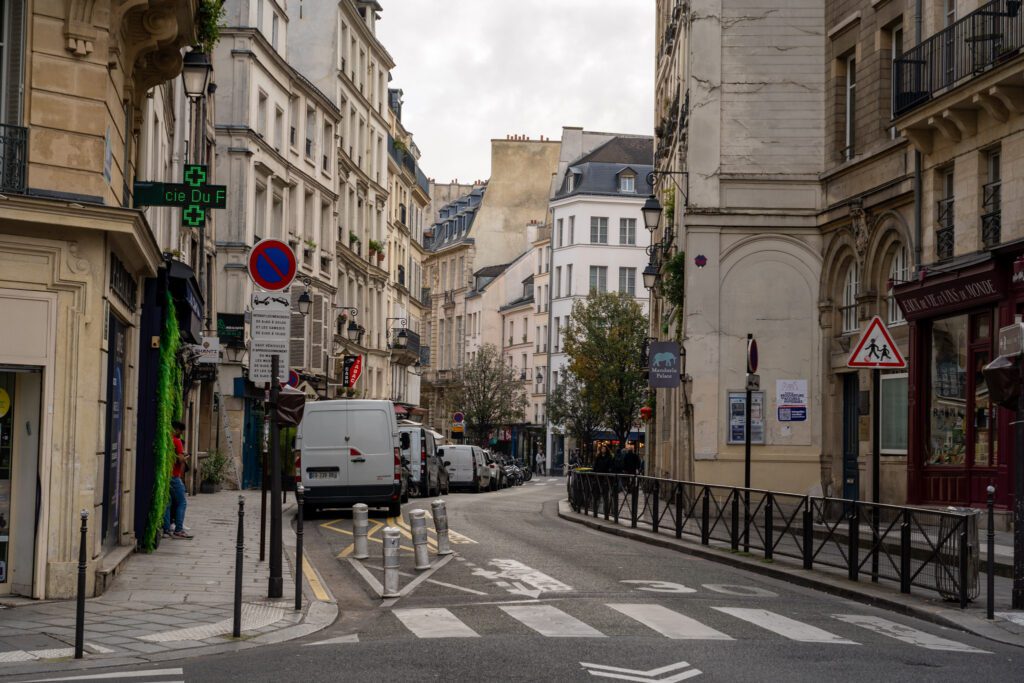
Le Marais, the 3rd and 4th Arrondissements, are just east of the Louvre, and are one of the few places in Paris where you can still find the narrow alleyways that existed prior to Napoleon III’s leveling of 60% of the city to make way for the grand boulevards you see today.
This is our favorite part of Paris, both to visit and to stay (it’s our top recommendation in our guide to where to stay in Paris).
In particular, we really enjoy the north end of the neighborhood – a little triangle bordered by Place de la République, Arts et Métiers, and Square du Temple – where you’ll find several of our highlights listed below.
This part of the city is a great place to eat, drink, and shop, and is worth a couple of hours of your time to absorb the architecture and vibes as you walk around and explore.
Here are a few of our favorite spots in Le Marais.
- The Marché des Enfants Rouges: This is an open air market that is full of bars and restaurants and is packed full of people around lunchtime basically everyday. Is it firmly on the tourist radar? Absolutely. Does that mean you shouldn’t go? Absolutely not. If you have the time, you should definitely swing by for lunch on one of your days in Paris.
- Kawa: This coffee is so good, I’ve ordered it to be shipped to me here in the States. Multiple times. Last time I was in Paris, I found myself here a couple of different times, and it didn’t disappoint. If you’re a coffee nerd, they have different coffee options prepared as either filter or espresso, along with a huge selection of both beans to take home, and brewing equipment.
- Place De La République: A bustling square with an important metro station and a big monument in the center. A corner turns into a skatepark in the afternoon, which makes for some really good people watching.
- Square du Temple – Elie Wiesel: We’re big fans of this green space, which is a bit of an oasis in the middle of the most bustling part of the neighborhood.
- Place de Vosges: Another of our favorite green spaces in Paris, this one is right in the heart of all the action, and was planned in the 17th Century (and still has basically the same footprint today). Good fountain, good architecture on the perimeter, and Victor Hugo lived in a house on the square!
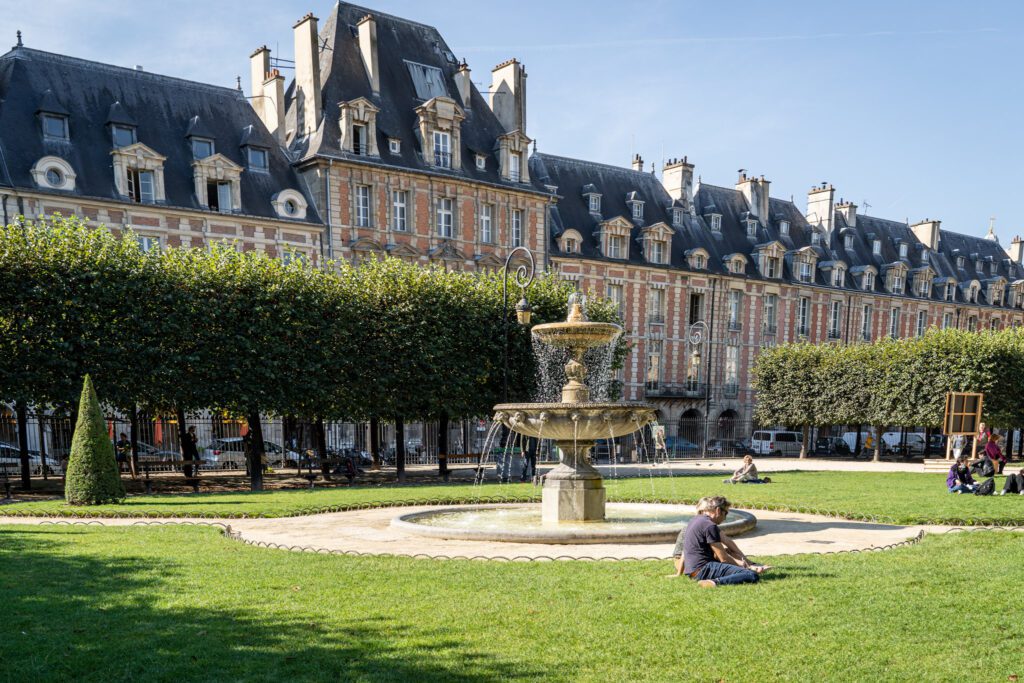
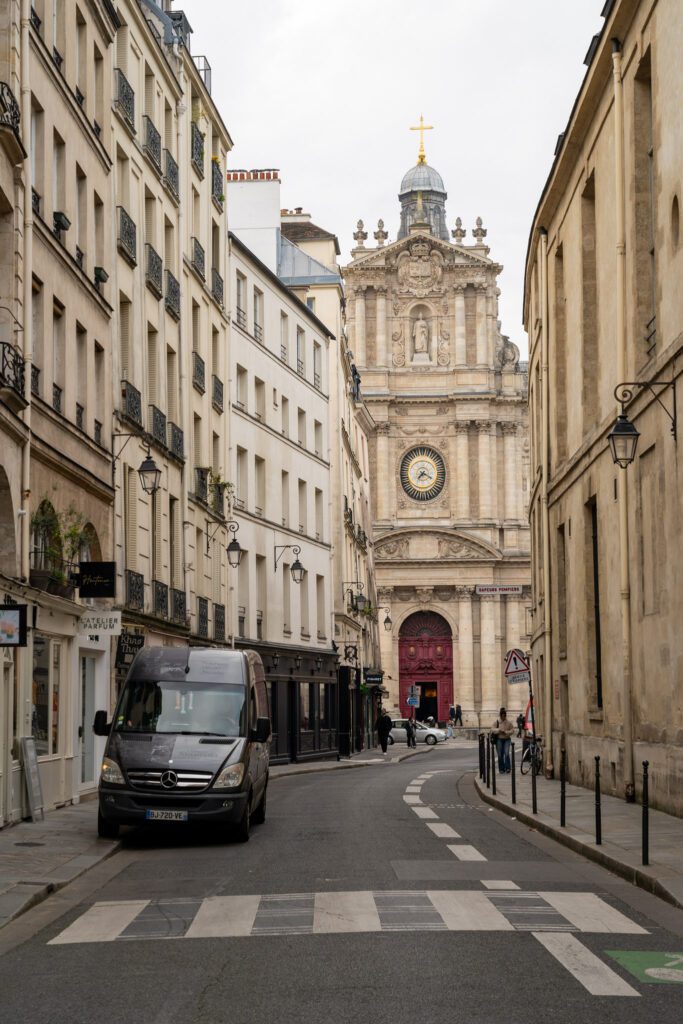
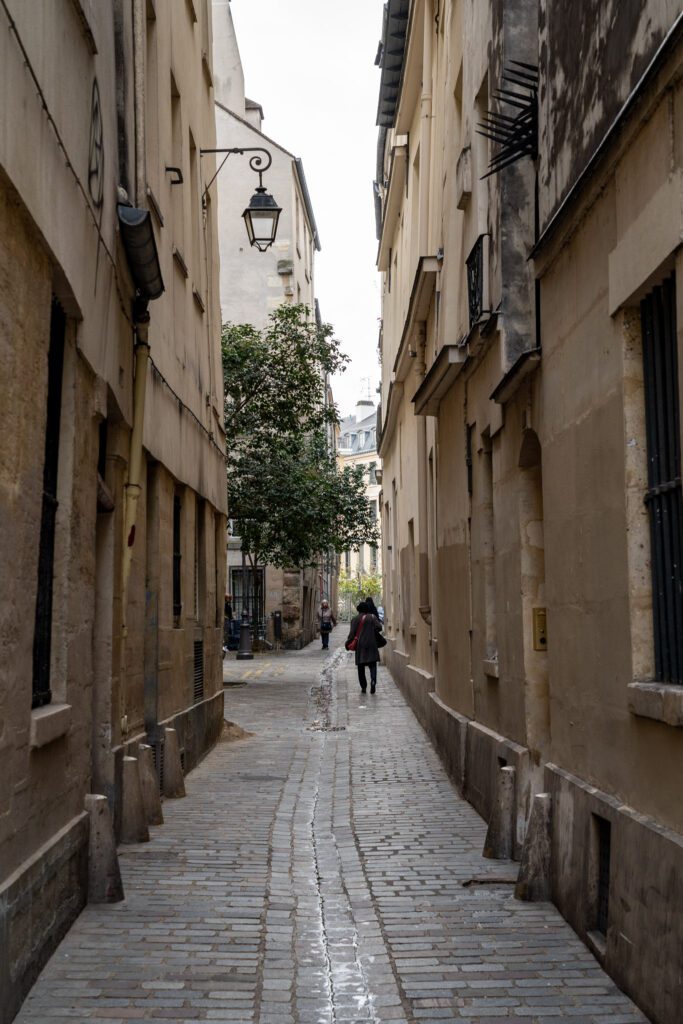
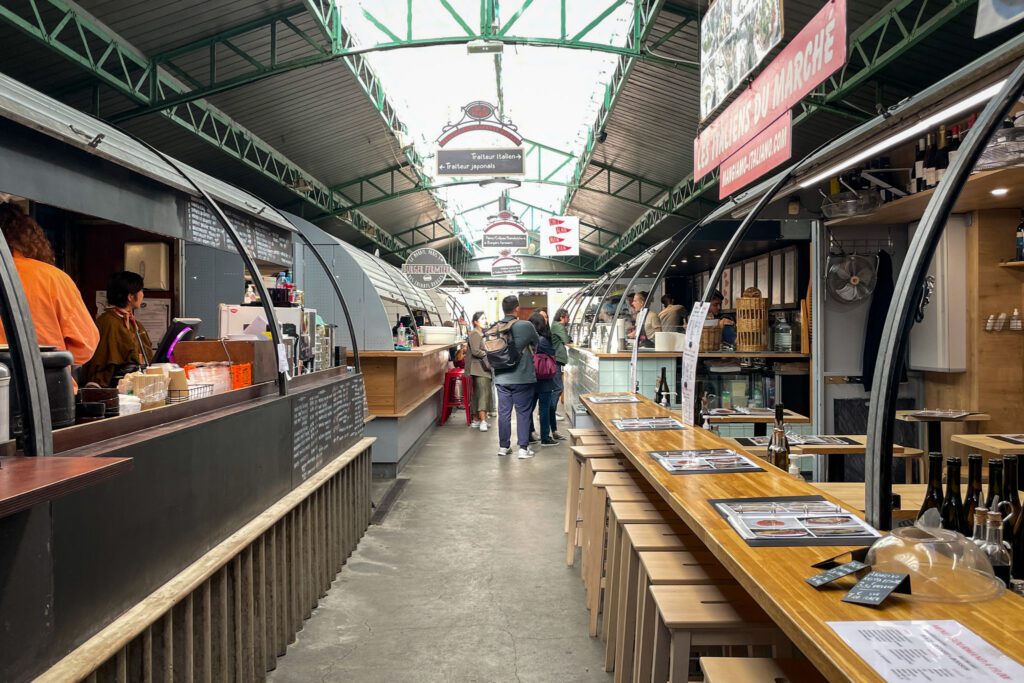
Choose Your Own Foodie Adventure
Diving into the food culture in places we’re visiting is one of our favorite aspects of traveling, and we try to include a food tour, cooking class, or market tour in most places we visit.
Unfortunately, the reality is that because Matt has Celiac Disease and can’t have even a speck of gluten without being sick for days, a food tour or cooking class wasn’t in the cards for us in Paris.
HOWEVER. That does NOT mean it shouldn’t be for you!
We’d highly recommend it because it gives you a local’s perspective on the city’s food scene – what and where to eat and drink – and you get to connect with fellow travelers and try some amazing food.
Here are some options for you, split between food tours and cooking classes. Our bias is to do a cooking class, because we LOVE to cook, but we also enjoy a good food tour.
Option 1: Dive Into French Cuisine in a Cooking Class
We’ve done all sorts of cooking classes around the world (read about our cooking class in Mexico City here), and while the gluten-filled nature of most French food made it nearly impossible to find one in Paris that meets our needs, that doesn’t mean you shouldn’t.
After all, haven’t you always wondered how to make the perfect croissant? Spoiler: you’re probably not going to want to do it more than once.
Here are a few cooking classes that would definitely be on our list if, you know, Matt could eat gluten.
All three of them are baking classes – because Paris is known for pastries – with Matthieu, a French chef who has a nice space in the heart of Saint-Germain (the 6th Arrondissement).
Learn to Make Macarons: Exactly what the title sounds like – learn how to bake macarons from start to finish, and walk away with your very own box of 15-18 to devour later. The class is gluten free, but the equipment is used in other classes (like the croissant class), so it’s not suitable for Celiacs (I asked because I wanted to do it, and they advised against it).
Learn to Make Croissants: Croissants might be the most iconic French pastry… and also the biggest headache to make. Where better to learn to make croissants than with the help of a real chef?
Learn to Make Éclairs: Strap on your apron and get down to making éclairs, including learning the ins and outs of choux pastry (a unique kind of pastry dough that doesn’t use rising agents, but employs steam to get fluffy) and get to make multiple versions of the famous éclair. Which you of course get to devour at the end.
Option 2: Learn About Food Culture Through a Food Tour
Here are some food tours that caught our eye though, sadly, we also skipped these because of the whole gluten and cross-contact issue.
Mingle at the Market – Taste Paris: This is part market tour, part tasting. You’ll meet at a local market over in the 11th Arrondissement and learn about Parisian food culture through experiencing the market and tasting a selection of foods at different stalls.
It’s a small group with a maximum of six guests, so you’ll have plenty of time and space to ask questions and really learn about Paris through the eyes of Natasha, the host, and her team.
NO DIET CLUB: First of all, their website starts with “Bye Boring Food Tours” and has a hilarious logo of a woman in a bikini riding a hot dog with a stein of beer and her middle finger up.
But what about their tours? They have several tours in Paris where they take you around to their favorite spots in a specific neighborhood, which is the style we’d recommend.
The tours last between three and four hours, and you need to show up hungry otherwise you’ll lose steam halfway through.
They have lunchtime tours in le Marais and Canal St. Martin, and an evening tour in Montmartre. If we had to choose, Canal St. Martin would be our pick.
An Afternoon / Evening in Montmartre
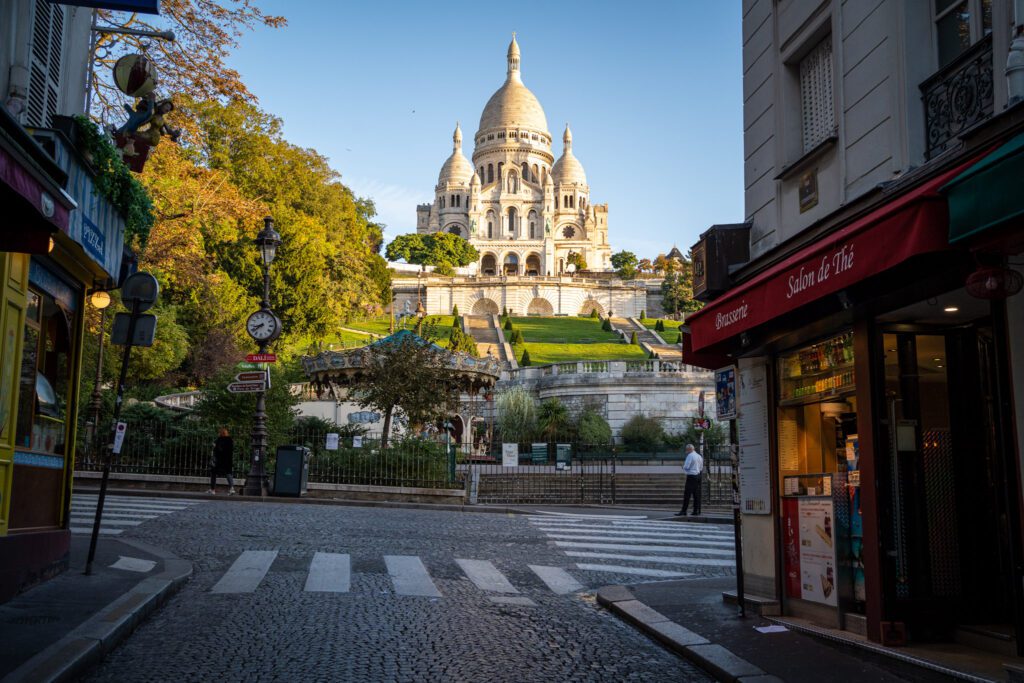
Montmartre, until the 19th century, was actually a completely separate town (though, it was adjacent to the borders of Paris).
It was a small village on the hill with some shadier parts, some green open spaces, and a bunch of windmills that were used to grind flour for the population of the city.
In the mid-to-late 19th century, it was famous for the soirees that were thrown on weekends, when wealthy Parisians would escape the city and amble up the hill to drink and dance in the gardens that provided a much-needed escape from the urban environment a few blocks away.
If you go to the Musée d’Orsay (and you should!) and learn about impressionism, you’ll see multiple depictions of this phenomenon, most famously Renoir’s Bal du moulin de la Galette.
It has also gained the reputation for being the home of the artists in Paris, with Vincent Van Gogh, Renoir, many other artists in the impressionist movement, and even Pablo Picasso having lived in Montmartre for some period of time in the late 19th and early 20th centuries.
Similar to Le Marais, Montmartre escaped the redevelopment projects that came with Napoleon III (again, not THAT Napoleon, but his nephew) that leveled huge swaths of the city to modernize it and turn it into the city you see today, with grand boulevards and wide open spaces (rather than narrow cobblestone streets).
Mostly, that’s because it was outside the boundaries of the city at that time.
The result is an uber charming neighborhood full of cobblestones, narrow winding streets, and excellent views out over Paris (which only get better the further up the hill you venture).
It’s charming. It’s romantic (especially before or after the bulk of the tourists arrive or leave). And it’s easy to see why it has become a staple of many itineraries.
Here are a few of our favorite spots in Montmartre.
Sacré-Cœur: At the top of the hill is the white church on the hill – Sacré-Cœur – which boasts one of my favorite views in Paris.

At the top, you’ll have an up close and personal view of both Sacré-Cœur itself, and the view from the platform just below it, which looks back towards the Seine and the center of Paris.
You can also climb the dome of Sacré-Cœur for even better views – it’s 200+ steps, and like most church towers, they’re narrow and claustrophobic.
Montmartre Walking Tour: As mentioned above, I did this tour on my recent trip and it was a great dive into what makes Montmartre special (beyond the Moulin Rouge).
All sorts of incredible personalities lived in Montmartre, which was originally a village on the hill outside of Paris’ city limits, including many of the impressionists (including Van Gogh) and Pablo Picasso.
This tour is a great deep dive into the history and culture of Montmartre, and takes a people-first approach to history that I liked.
Clove: Tucked away on a side street a block away from Sacré-Cœur, you’ll find one of our favorite cafes in the city. I spent part of a morning here chatting with the owners (one of whom is American) and getting to know their philosophy around coffee.
They work with various European roasters that change every so often, and one of the things I noticed was the beautiful ceramics.
When I asked the barista about them (and complimented the beautiful drinkware), she informed me that she had made all of them herself, which I think is a lovely touch.
If you’re a coffee nerd like me, go here and have them help you explore some new coffees!
La Manufacture de Sans Gluten: This tiny gluten free bakery makes, hands down, one of the top three gluten free croissants I’ve ever eaten (they keep them in a warming case, which helps a lot). Flaky, buttery, and light – which is hard to come by when we’re talking about gluten free pastries. They’re pricey, but they’re pretty clearly the best gluten free pastries in Paris, so…worth it!
Pain Pain: If you’re not gluten free, this bakery came highly recommended by the tour guide of the aforementioned walking tour (and a couple who I met on a different tour who was rating their favorite bakeries in Paris). I stopped by to check out the selection, and was drooling at all the options, sweet and savory, on display.
There are two restaurants in Montmartre that came highly recommended by two locals I met over the course of my most recent trip (neither are great for Celiacs, unfortunately).
They are Bouillon Pigalle, which is very popular (especially with tourists) but is still a good value and serves authentic French food (but be prepared to wait in line during peak times), and Crêperie Brocéliande, which is the place to go to try gallettes, a savory buckwheat crepe hailing from Brittany that is generally served with cider.
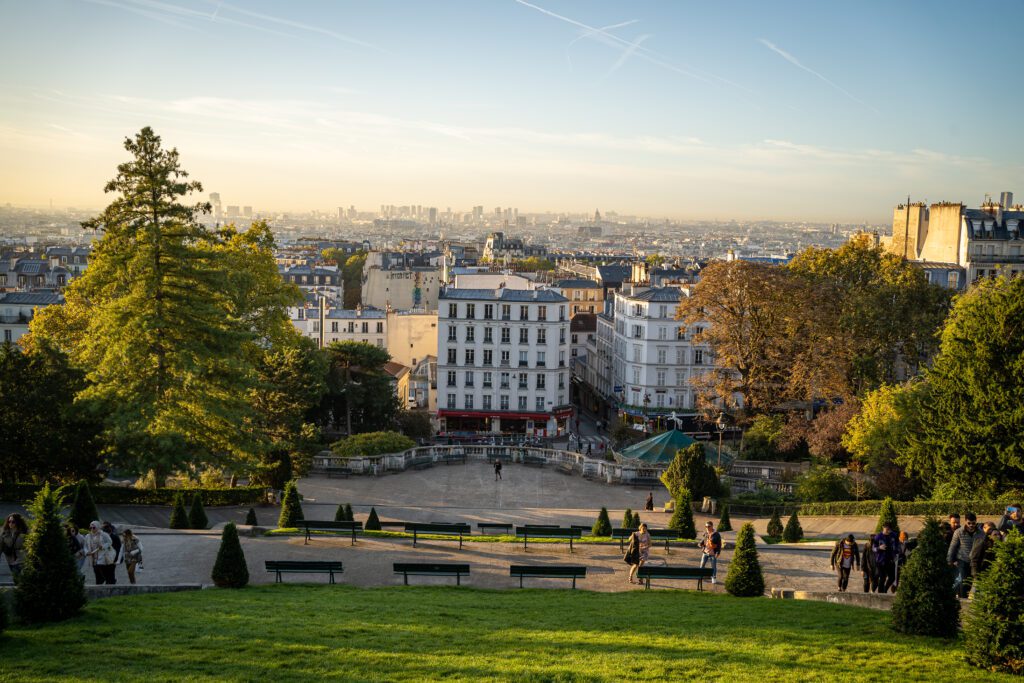
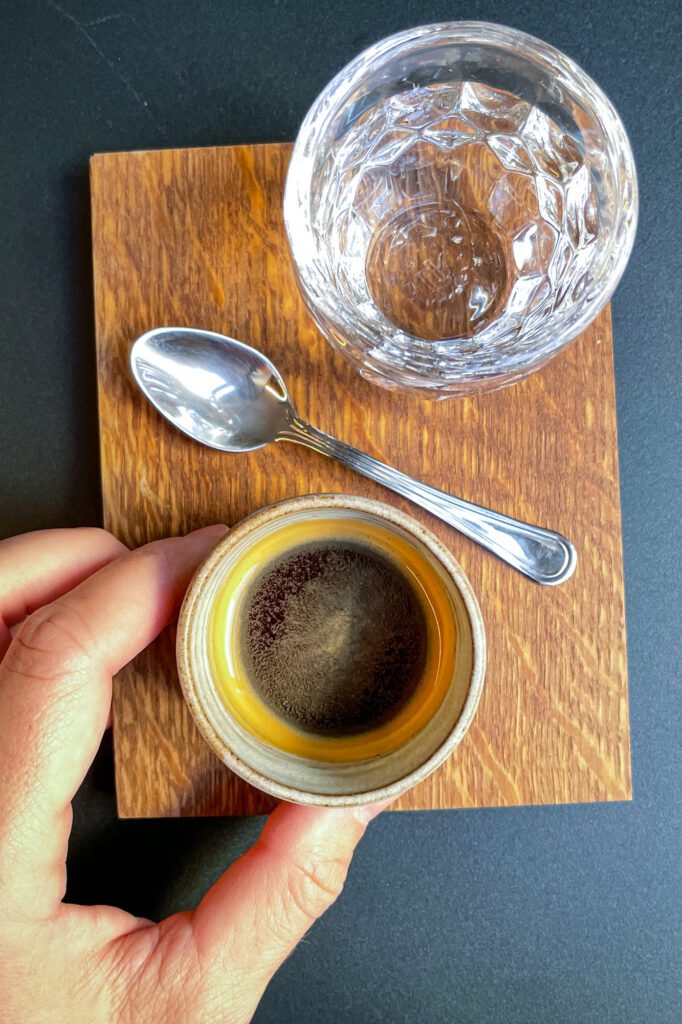
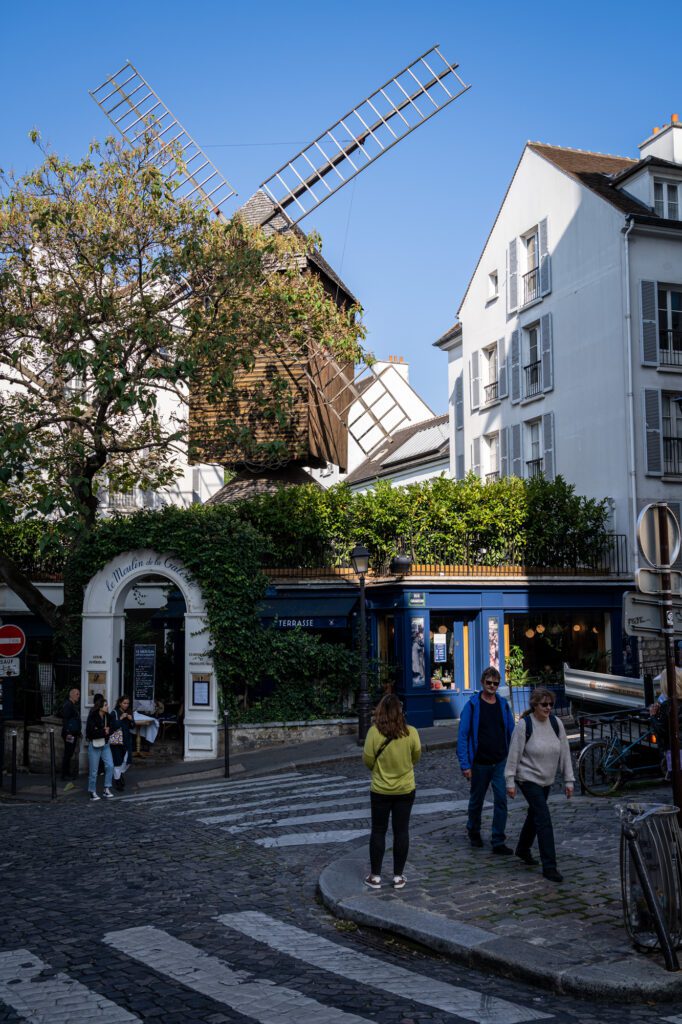
Day 4: A Day Trip to Versailles
As we mentioned at the beginning of this itinerary, the choice to include Versailles here might be a bit controversial.
We would absolutely not spend time in Versailles with anything less than four full days in town, and even that is pushing it we’d say.
However, it does tell an important story about the French Monarchy, and Versailles is, by far, the most incredible royal palace I’ve ever seen (and I’ve been to quite a few at this point).
The amount of gold on display rivals St. Peter’s Basilica (and serves the same purpose; the projection of power), and it’s hard to believe that someone actually lived here.
Which brings us to a key question: What was this place?
Basically, King Louis XIV was getting sick of living in Paris amongst the peasants and decided to commission his own royal palace (on the site of an existing hunting lodge) outside the city, removed from the squalor of his people.
Which, OOPS, sort of continued the French monarchy on a path to ruin because it showed that the king wasn’t a man of the people AND the monarchy was broke and couldn’t really afford a new royal palace.
The former royal palaces are the Louvre, which was turned into a museum, and the Palais-Royal, which was given to a previous king (and Louis XIV abandoned it, giving it to his somewhat debaucherous younger brother).
Anyway, Versailles is worth the better part of a day of your time to wander its halls marveling at the architecture, art, and, well, gold. Definitely don’t miss the gardens either, which are equally as impressive (we think) when things are in bloom and the fountains are fountaining.
I should say here that we’re generally not a fan of the palaces of rich people because they’re usually not particularly interesting, and we don’t need to see some old king’s fancy art collection. Which at least partially applies to Versailles.
The other thing to know about Versailles is that it’s a short (90 ish minutes each way) train ride outside of Paris, which means that you’re going to spend a bit of time in transit to get here.
Last, but certainly not least, is that Versailles is going to be crowded AF, and there’s basically no way to get around it. Especially mid-morning when all the tour buses rock up.
The point here is that it’s very much not worth it if you either:
- a) don’t care about a decommissioned royal palaces that are just one big obscene display of wealth
- b) you have less than four or five days to spend on Paris (with less than that, we’d argue you’re better off staying in Paris)
- c) you’re not interested in being one of 200 people in a room with a capacity of 50 people looking at a painting of the aforementioned rich guy
We’re not saying we hate Versailles at all – it’s actually an interesting place from a historical and cultural perspective because it was one domino on the road to the French Revolution – but it is very much a busy tourist attraction, and you should set expectations accordingly.
Whether or not to do a tour here is somewhat more complicated than museums in Paris.
A tour means you’re going to be on a strict timeline and, unlike a museum tour that ends inside and affords you the ability to continue exploring, a tour here likely includes transportation from Paris.
On the other hand, the security lines at Versailles are LONG, and guided tours with a licensed guide get to use a separate entrance with shorter security lines.
I have a couple of recommendations for tours of Versailles that I had bookmarked for my recent trip to Paris (I ended up cutting Versailles because I had done it multiple times before and it was November, which means the gardens are gray, drizzly, and dead).
I think they offer a somewhat unique approach to visiting Versailles.
The first is this full day bike tour, which spends a full day out at Versailles and includes some time exploring the less-visited nearby sights, including the town of Versailles itself.
Being on a bike makes it a little more feasible to cover this much ground (you’re only on a bike outside the palace and gardens, if you’re wondering).
For what it’s worth, that would be my top choice if I were going to do a tour of Versailles tomorrow because I think it’s a unique approach to visiting one of the most popular tourist attractions in France.
The second is this more traditional tour of Versailles with a Parisian tour company (which I appreciate).
It includes transportation to and from Paris, but it does end at the palace (which gives you more time to explore if you want) and spends a fair amount of time (three hours or so) on the palace and gardens.
Some tours try to do it all – palace and gardens – in an hour and a half, which I think is madness.
The palace at Versailles is closed on Mondays, so plan accordingly.
Getting to Versailles
To get to Versailles from Paris, the easiest route is to hop on the RER-C.
The line runs along the Seine (which means it’s easily accessible). Take it to the stop called “Chateau Rive Gauche” (here on Google Maps). From there, it’s a short walk to the entrance.
This route takes roughly 90 minutes, maybe a bit shorter depending on the day and where you’re riding from.
However, the RER-C has some notable downsides, like the fact that it’s subject to closures and delays.
Another option is catching the N Train from Gare Montparnasse, which is MUCH faster but takes you to a different station (Versailles-Chantiers) that means a longer walk to the palace.
There’s also an L Train from Gare Saint-Lazare to Versailles Rive Droite (you need to make sure you get on the line that goes there) that gets you to the chateau in a similar manner, but is probably less convenient unless you’re staying in the 9th or Montmartre.
Tips for Visiting Independently
Definitely book tickets in advance here and try to get either an early morning entry or, alternatively, a later afternoon entry (think 2-3pm or so), when the palace is relatively quiet.
You’ll still have to wait in the (sometimes long) security lines.
If you want to see the gardens and it is high season, book the “Passport” which includes the palace, gardens, and Estate of Trianon.
In the low season, from November through March, the cheaper Palace ticket actually includes the gardens (but NOT the Estate of Trianon, if you want to see that).
This is another place where I highly recommend the audio guide, at least partially because it’s crowded and you won’t always be able to get up close to read the signage.
More Paris Travel Guides
Planning a trip to Paris? Matt, who speaks French “really well for an American” (as multiple French people have told him – it’s his proudest achievement in life), loves Paris.
As you get into planning your trip, you might find some of these other detailed guides we’ve written about Paris helpful.
What to Do with More Time in Paris
If you have more time in Paris, there’s still plenty to do and see. I recently spent 10 full days exploring Paris and never once ran out of things to do (here’s our complete guide to our favorite things to do in Paris), see, eat, or drink.
However, our best advice here is to take the things above at a more leisurely pace, spending more time savoring the sights, sounds, and tastes of Paris.
Go Deeper with a Walking Tour
Over the past few years, we’ve come to the realization that walking tours are often our favorite way to get oriented in a new city for a few reasons.
First, you get a crash course in history and culture, which is a valuable baseline that will make the rest of your trip more enjoyable.
Second, you get to spend a few hours with a local who will give you all sorts of tips about what to eat, drink (and see), and specifically where to find the best version of said things.
Last, but not least you’ll discover places that you definitely would never have found on your own.
We almost always start our trip with a walking tour for these reasons (and the fact that it’s helpful to get outside and move to combat jet lag).
Like we mentioned above, Paris is slightly too big to really cover a bunch of ground on foot, but what you can do is explore a far more targeted slice of Paris with a local to get a deeper understanding of the culture and history of a time period or neighborhood.
I have done several of this type of tour over my trips to Paris.
Here are three tours that I’d look at, two of which I have personally done and enjoyed.
The French Revolution Tour: On a trip to Paris a few years ago, I discovered Thierry’s tours near the end of our visit, and wasn’t able to make the timing work with our schedule.
I bookmarked them and saved them for a future trip and, on this most recent trip, ended up doing two of his tours.
Thierry is a (very passionate) historian who will dive into French history’s important moments – in this case, the French revolution – and spend a couple of hours teaching you the basics of what happened, who was involved, and how it affects France today.
He’s an engaging storyteller, and this tour in particular was a favorite because I, an American, didn’t learn that much about the French Revolution in school, so this filled in a lot of gaps.
I also did his Napoleon tour – I’m particularly interested in Napoleon and his impact on Europe’s modernization and liberalization – and found it to be a great way to set the record straight for people who didn’t learn anything other than “short dictator” in school.
Medieval Paris Walking Tour: This tour is with Walks, one of my favorite tour companies in Europe with whom I have done multiple tours, including one in Paris (though, for transparency’s sake, not this one).
I had this tour on my radar for my last trip, and it ended up getting cut to do other things (mostly drink coffee, walk, and eat more gluten free pastries).
It focuses on the medieval core of Paris, which is Île de la Cité and the area around it, and includes entry to both Notre Dame and Sainte-Chappelle, two must-see churches in Paris (I think). It will give you a nice baseline for understanding the city, its layout, and its history.
The Rodin Museum
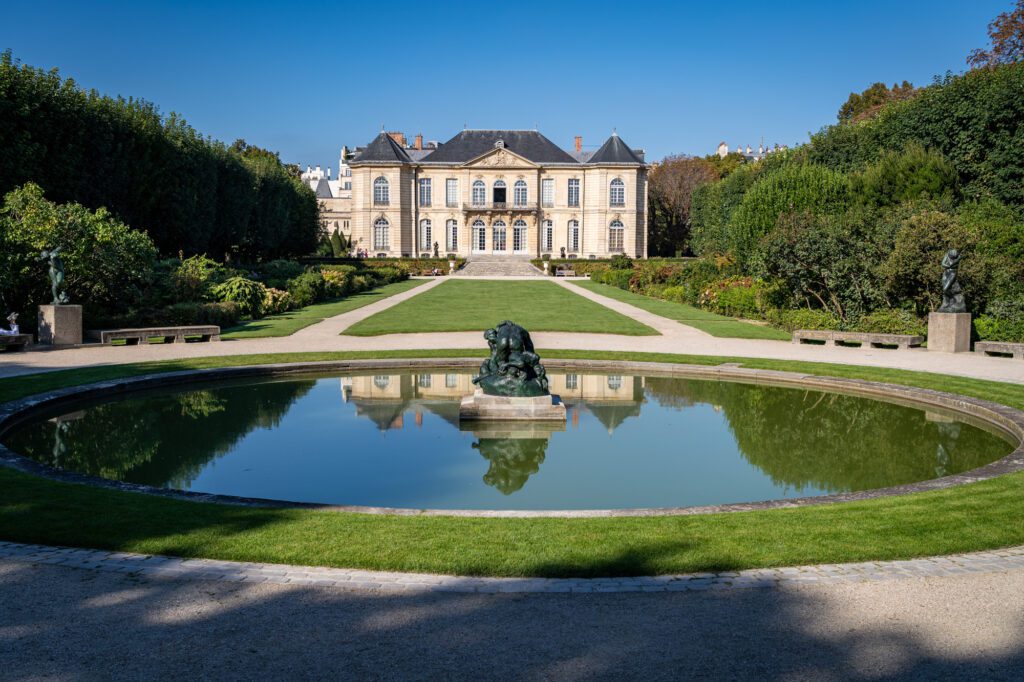
This might actually be our favorite museum in Paris!
The reason we like it is that, rather than being a huge collection of art cobbled together by some rich family centuries ago, it follows the life of the famous sculptor Auguste Rodin, and shows his progression throughout his life from his first official works to world-famous pieces like the Thinker and the Gates of Hell.
The garden (really, it’s a sculpture garden) is gorgeous too, and well worth walking around. Get the audio guide – it’s excellent!
It’s in the 7th Arrondissement. More information like hours and costs here.
Take a Seine River Cruise
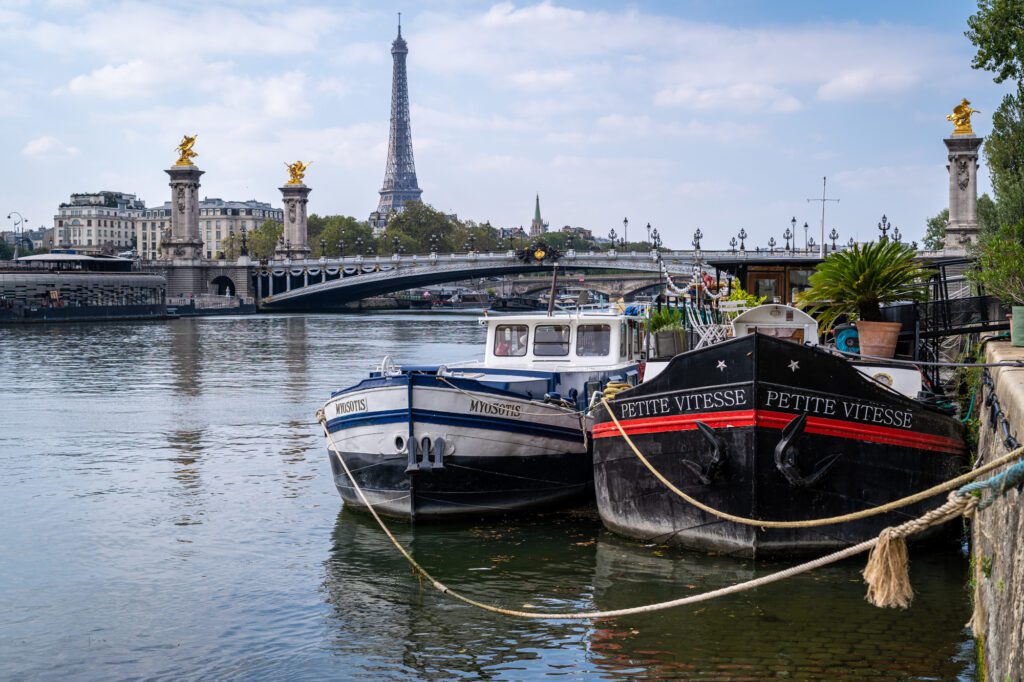
To be completely honest, we’ve never actually done this ourselves. The reason it shows up here is twofold.
One, I did a canal cruise in Amsterdam on a recent trip that turned out to be one of my favorite things to do in Amsterdam, and offered a completely different perspective of the city than I had previously gotten.
Second, I have heard from both readers and fellow travelers that this is consistently one of their favorite things to do.
There are hundreds of versions of this cruise, and my advice would be to choose one with a smaller company and, ideally, a smaller boat where you get live commentary or a live guide where you can ask questions and actually learn about the city.
What To Do with Less Time in Paris
With less time in Paris, we’d recommend cutting the number of things you’re trying to fit in. The alternative – trying to fit the same number of attractions into a shorter time – will leave you needing a vacation from your vacation. I’m speaking from experience here.
The first thing to cut is the day trip to Versailles. It’s cool, sure, but at the end of the day it’s just a rich person’s palace with some beautiful gardens.
We love the Jardins du Luxembourg in the 6th Arrondissement (included in the itinerary above), which are a little less manicured, but are a good substitute.
3 Days in Paris
With three days, cut the day trip to Versailles and follow the itinerary as written above for days 1-3. This is an easy one.
2 Days in Paris / A Weekend in Paris
If you’ve only got a couple of days in Paris, the first thing we’d do is choose between the Louvre and Musée d’Orsay.
There’s so much to see in Paris that, with only a couple of days, we don’t think it makes sense to spend 3-4 hours on each museum, which is the amount of time you’d need to do them both justice.
The second thing we’d recommend is to pick two of the neighborhoods on day 3, and we’d recommend that you choose Montmartre and Le Marais (sorry, Canal St. Martin!).
Here’s what two days in Paris could look like.
- Day 1: Montmartre, Le Marais, and the Eiffel Tower
- Day 2: The Gothic Cathedrals, a Foodie Adventure, the Louvre, and the Arc de Triomphe
You can still use the relevant sections of the detailed 4 day itinerary above to plan out the specifics of your weekend in Paris.
One Day in Paris
Our first tip for spending a day in Paris is to book a second (or third).
Joking aside, trying to see it all in a day just isn’t going to happen, which means you’ll need to prioritize and make some hard choices on what to save for next time.
One big assumption we’re going to make here is that you want to see the Louvre. If that’s true, that’s going to eat up a significant chunk of time that you’re going to have to plan around. You could easily swap the Louvre for the Musée d’Orsay, if you’ve already done the Louvre before, or want something a little different.
We’d also highly recommend investing in a 24 hour Metro Pass to make getting around Paris more efficient.
Here are the things we think you should focus on with one day in Paris:
- The Louvre OR the Musée d’Orsay
- The Gothic Cathedrals and Le Marais
- The Eiffel Tower
We’d start with the Louvre when they open (go to Telescope Coffee, some of the best coffee in Paris, nearby for coffee and pastries beforehand!) and spend the morning exploring their extensive collection, preferably on this guided tour, which we recently did and loved.
Then, make your way east through Le Marais, stopping at the Marche des Enfants Rouge for lunch and exploring the 3rd and 4th Arrondissements en route to the two Gothic Cathedrals, Notre Dame (the interior and bell tower are closed indefinitely, but it’s worth admiring the twin towering bell towers from outside) and Sainte-Chappelle.
To end your day, take the metro over to the 7th Arrondissement to end your day in the shadow of the Eiffel Tower.
Relax there for a bit, then walk under the tower (go up to the top if you want – make sure to book tickets in advance) and take in the view from Trocadéro, which is across the river to the west and has our favorite views of the tower.
Important Tips for Visiting Paris
During your trip to Paris, you’ll come across some of the clichés about Parisians, as well as some specific French lifestyle elements that are worth knowing about.
Set Your Expectations
Here’s the thing about Paris. Paris is very, very polarizing.
Some people rave about it and can’t get enough of it. Some people come back from their first trip to Paris and say it was underwhelming and that French people are surly and mean.
I think it all comes down to expectations.
Paris is not a city in a fairytale, which I think is what many first-time visitors build it up to be.
They have this romantic ideal in their head, where they’re strolling by the Seine with a red beret on their head, hand in hand with their lover on their way to a cozy bistro for dinner.
While that can certainly exist in Paris, it’s leaving out the part where there are cars honking, you just stepped in dog poop and are frantically trying to wipe it off on a leaf or the curb, and you’re running late because the metro was delayed.
The romantic ideal of Paris is forgetting that Paris is a real city, a city full of tourists, and a big city, which means it has its fair share of problems.
It’s a little dirty (not as clean as Seville or Madrid, not as dirty as Rome), it’s a little crowded (especially on the metro at peak times), and it’s true that sometimes, Parisians can come off as unfriendly.
But on the other hand, it’s also an amazing city full of world-class art museums, a pretty great food scene, romantic neighborhoods full of narrow cobblestone streets like Montmartre, and tons of history and culture to dive into and learn more about.
If there are two things I want you to know before you go to Paris, it’s these two.
First, remember that Paris is a real city, and that the people living there are real people. There are great things about Paris, and there are annoying things about Paris.
We’ll do our best to help you see the great things and minimize the annoying things. Or at least be aware of them going in.
Second, don’t try to fit it all in. Trust me, I’ve done that trip. I’ve run around from museum to museum, and seen it all, but absorbed almost none of it.
Instead, focus on a couple of main attractions (we think they’re the Louvre, the Eiffel Tower, the Musée d’Orsay, and the Rodin Museum) and save some time to connect with locals on a walking tour, food tour, or cooking class to learn more about what makes Paris tick.
Learn Some French – A Little Goes a Long Way!
Don’t be put off by the myth that Parisians are rude and unaccommodating to tourists. Generally speaking, it’s an outdated idea, and it usually comes from someone who hasn’t been to Paris in a decade or two.
The reality is that it basically comes down to a mismatch of expectations (again) around manners.
Specifically, greetings.
You need to make sure to greet everyone before you get into the interaction! For example, saying bonjour before ordering coffee from a barista.
As long as you greet everyone with a smile and a Bonjour – which is perhaps the most important part! – and make sure to be polite, most locals we’ve encountered have been absolutely lovely.
It will help if you learn a few important French phrases.
In our experience, people are always happier when you make an effort to use their own language. Not just in France, but just about everywhere in the world.
Here are some useful phrases to learn, and my attempt at phonetic spelling.
- Bonjour (bone – jure) – hello / good day
- S’il vous plaît (seal voo play) – please (“if you please”, literally)
- Merci (mare – see) – thank you
- Je voudrais (jeuh voo – dray) – I would like (this is the polite way of saying it, I think)
- Pardon – (par – do) – excuse me
- Excusez-moi (excuse – ay mwah ) – excuse me (different way to say it)
- Désolée (dez – oh – lay) – sorry
Here’s a more comprehensive guide to French phrases to learn, or you could pick up a small French phrasebook to help you learn French as you go.
The Crowds Are Going to Be Intense (There’s No Real “Low” Season)
After a recent trip to Paris in November, I talked to multiple guides, restaurant owners, and baristas, and they all said some version of the same thing: “there is no low or shoulder season anymore.”
This is true of most of the main cities in Europe, and certainly applies to Paris: the age of shoulder seasons that have meaningfully lower crowds is a thing of the past.
However, the one thing I would say is that the makeup of the crowds changes by the season (for example, you see more kids and families in the spring and summer, and more young people and retirees in the fall).
I wouldn’t expect to show up in Paris at any time and find it quiet (except, ironically, during the Olympics, which almost every Parisian I talked to said was relatively quiet, in a bad way for tourist-centric businesses).
My point is that there is no time when you can visit the Louvre, the Eiffel Tower, or the Arc de Triomphe and have them to yourself.
It’s just not going to happen. Even in November, the lines to access the Louvre were wild (though less wild than, say, July).
I talked to multiple people in the tourist industry, and generally the lowest seasons are November (when it’s likely to be gray and drizzly, which I can personally confirm) and January/February (when it’s more likely to be colder, but you also tend to get more blue skies).
March to October (and December for Christmas)? Busy busy busy.
Now, here are three things you can do to avoid crowds, to the extent that it is possible.
- Walk around key spots – like Montmartre or along the Seine – before 8am or after 10pm (ish)
- Pre-book main attractions to avoid missing out on experiences.
- Book tours that offer off peak times (early morning or night tours)
Book Your Big Attractions in Advance
One thing that can be confusing, especially if it’s your first time in Paris or in a big European city, is that there are often two separate lines at most main tourist attractions: the line for the ticket office, and the line for security.
A pro-tip here is that you can completely bypass the line for the ticket office at most major tourist attractions by booking a timed entry slot in advance.
However, there are two considerations to keep in mind here.
One, booking in advance obviously means you’re sacrificing flexibility, which may or may not be something you care about.
But think about it this way: by booking a Louvre timeslot in advance, you’re likely saving yourself a couple of hours of waiting in line at the ticket office. Which seems worth it if your time is limited!
This is really only important when it’s weather-related, I think. You might not want to go to Versailles on a gray, rainy day if you know it might be sunny on a different day.
Two, some popular attractions – like the Louvre and Musée d’Orsay – have a limited number of slots available on a given day, and they will sell out online in advance.
If that’s the case for your dates, then you have two options: book a tour that includes entry, or show up on the day of and wait in line at the ticket office (they usually have tickets set aside for walk up, but the lines can be long).
Here are the attractions I would put in that “book in advance” category:
- The Louvre
- Musée d’Orsay
- The Arc de Triomphe
- Notre Dame
- The Orangerie
- The Picasso Museum
- Sainte Chappelle
Other attractions, like the Pantheon or Rodin Museum, can generally be booked online a few days in advance (which will save you time by avoiding the ticket office line), or on the day of.
Other Things to Know About Visiting Paris
Here are some other things to know going in that we jotted down on our latest trip. Some are useful, some are funny, some are good to know, and we hope that all of them will help you have a more enjoyable trip.
- Many shops and convenience stores are closed on Sundays so check hours in advance. Even grocery stores and other places you’d expect to be open if you’re coming from the US or Canada.
- Similarly, museums and places of interest typically have a day a week when they’re closed, but it’s not always the same. Check before you go.
- Paris is MASSIVE. We spent the first day or two trying to walk everywhere, and after multiple 30,000 step days decided to use the metro. With limited time, get acquainted with the metro and bus system, which will allow you to get around much more efficiently. We used this app for navigating the metro. It’s well worth investing in a Visite Pass, which gives you unlimited bus and metro rides (you only need zones 1-3, really).
- You’re still going to be doing a lot of walking on this itinerary, and you’ll need to watch where you step because there is dog poop everywhere.
- Wear comfortable shoes, and leave the heels at home. There’s a lot of cobblestones and uneven footing in Paris, and if you’re doing a lot of walking, you’ll want your feet to be comfortable.
- Everybody in Paris smokes. Or it seems that way to us. It has to be at least 50% of adults. Anytime you’re eating or drinking outside, there is almost guaranteed to be someone smoking nearby. Good to know going in.
- Tipping isn’t as much of a thing. Servers in Paris get paid a living wage – something we should probably consider in the US (don’t @ me with “but small businesses”) – and tipping is more about rewarding good service than a requirement so the server can pay rent. It’s still nice to give a 5-10% tip at sit-down restaurants with good service, and you won’t get a receipt with a tip line – either tip in cash, or tell them the final amount you want to pay before they run your card (e.g. if the bill is 50 Euros and you want to tip 5, tell them “55 Euros, s’il vous plaît”).
Read More: Essential Paris Travel Tips for First Timers (coming soon)
More Paris Travel Guides
Planning a trip to Paris? Matt, who speaks French “really well for an American” (as multiple French people have told him – it’s his proudest achievement in life), loves Paris.
As you get into planning your trip, you might find some of these other detailed guides we’ve written about Paris helpful.

What an amazing amount of information. I just booked the ChouChou Hotel in the 9th arrondissements foe what will be our first trip to Paris. Your information will definitely be used to help plan our trip. Abs when the time comes to book tours I will certainly use the links you have provided as this much information is surely worth you making a few dollars off anyone that uses it as a guide.
Just a thanks for taking the time to give such detailed information about the sights and sounds of Paris. I am truly looking forward to see this magnificent city in April of 2023.
Paris is great (as long as you go in with the expectation that it’s a real city where real people live, not a fairytale). The 9th is a nice home base – definitely don’t miss Aji Dulce, a Venezuelan place there with amazing arepas! It was a food highlight of our trip, for sure. Enjoy!
WOW!! THANK YOU so much for all of this AMAZING information! We are more excited than ever to go now in 3 weeks for our 2 year anniversary. All of the info, links, maps…is priceless. You have made planning our trip so much easier as we were a bit overwhelmed and do not speak French. Thank you!!! We will definitely be sharing your blog with others. We so appreciate all of the work you put into creating this great site! MERCI!
Wendy & Kevin
Hey Wendy and Kevin! A bit late here, but I sincerely hope you loved your honeymoon. Thanks for the kind words – cheers!
This was amazing. Almost perfect for my trip with my daughters in early November to celebrate our bdays. Ty so much
Hey Iris! Hope you had a great trip. Thanks for the kind words – we appreciate you taking the time to write them. Cheers!
Hi, a few questions:
I will be in Paris in Feb is there anything you would change from this itinerary given the weather?
Is staying in the 14th Arr a deal breaker in your opinion? (In terms of transportation and just being too far away)
Thanks for any input and advice!
Hey Elizabeth! I wouldn’t change anything, but I would be prepared for the rain and cold with layers and an umbrella. I was in Paris in late November last year for 10 days to make updates to this guide and I’d imagine the weather will be similar in February.
In terms of the 14th, it’s actually one of the better options outside of that first layer of arrondissements because it has the train station, which means good connections to the rest of the city (and Versailles!). If I were you, I’d try to stay at the northern end of the neighborhood (closer to the train station and 6th) just for convenience.